Questo documento in html e' stato da me adattato da un documento
di Microsoft, che puo' essere scaricato cliccando qui
ftp://ftp.microsoft.com/bussys/winnt/winnt-docs/papers/DNSWP.exe
altre info
ftp://ftp.microsoft.com/bussys/winnt/winnt-docs/papers/dnsinstall.exe
chiramente tutti marchi ed i nomi presenti in questa pagina non sono miei, ma dei rispettivi proprietari.
In questa pagina ogni tanto viene fatto qualche riferimento ai
documenti RFC.
per trovarli si puo' usare questo link
Search through RFC Database
**********************************************************************
DNS and Microsoft Windows NT 4.0
This paper provides an overview of the Domain Name System (DNS) and how it can be implemented using Microsoft Windows NT 4.0.
With the onset of Enhanced Directory Services for the Windows NT operating system, which will be coming in a later release of Windows NT, the Domain Name System Server will be much more important than it was in any other Windows NT release. Because of this, installing and designing effective DNS implementations today will help with tomorrow’s migration to the next version of Windows NT.
The DNS service that ships with Windows NT 4.0 is there if you need to use it, however there is nothing in Windows NT Directory Services today that requires it. We would like you to start using it for typical DNS-type activity.
|
|
It is important to note that DNS is NOT an alternative way to look at your Directory Services Domains (that is there is no Browser or Netlogon support and so forth). |
If you choose to use DNS, this paper shows you how you may want to design your DNS infrastructure today in preparation for the future release of Windows NT Enhanced Directory Services (DS).
What we are about to experience is a paradigm shift. Up until today, the group using Windows NT within a company could play in their own world and design Windows NT domains, trusts, user accounts, shares, and so on. The Windows NT groups never had to worry about the Directory Services world—there was usually some other group within the company that worried about X.500, DNS, and similar services. With the onset of the Enhanced DS, which is slated to be in the next major version of Windows NT, this will change and these two groups will have to work together. This will be important because the Enhanced DS will be similar to X.500 and will use DNS to locate servers providing these Directory Services. That is why this paper is important. It will allow the groups using Windows NT to gain an understanding of the other Directory Services that are available. This paper is intended to help these two groups understand each others needs so that a smooth migration to enhanced Directory Services can occur.
This paper will first define the DNS technology (this is an important section for anyone that is new to DNS). It will then take a look at the Microsoft specific DNS (in this section, we talk about why the Microsoft DNS solution is the correct choice for a Microsoft or mixed environment), it will then go over some architectures (this section is important for anyone that is about to design a DNS solution) and last, will talk about the future of Windows NT (this is an important section for everyone to read).
We hope you enjoy this paper and find it of value. If you have any comments concerning the contents of this document, please e-mail Scott Suhy (scottsu@microsoft.com) or Glenn Wood (glennwo@microsoft.com) with Microsoft Corporation.
Before we examine the Microsoft implementation of DNS, it is important for the reader to know a little bit about the history of DNS. If you are already familiar with DNS and its functionality, you may want to skip past this section of the paper and go directly to "Implementing DNS using Windows NT 4.0."
The Domain Name System (DNS) is a set of protocols and services on a TCP/IP network which allows users of the network to utilize hierarchical user-friendly names when looking for other hosts (that is computers) instead of having to remember and use their IP addresses. This system is used extensively on the Internet and in many private enterprises today. If you’ve used a Web browser, Telnet application, FTP utility or other similar TCP/IP utilities on the Internet, then you have probably used a DNS server.
The DNS protocols best-known function is mapping user-friendly names to IP addresses. For example, suppose the FTP site at Microsoft had an IP address of 157.55.100.1. Most people would reach this computer by specifying FTP.microsoft.com and not the less friendly IP address. Besides being easier to remember, the name is more reliable. The numeric address could change for any number of reasons, but the name can always be used.
Before the implementation of DNS, the use of user-friendly computer names was done through the use of HOSTS files which contained a list of names and associated IP addresses. On the Internet, this file was centrally administered and each location would periodically download a new copy. As the number of machines on the Internet grew, this became an unmanageable solution. The need for something better arose. This better solution became DNS.
According to Dr. Paul Mockapetris, principle designer of DNS, the original design goal for DNS was to replace this cumbersome singularly administered HOSTS file with a lightweight distributed database that would allow for a hierarchical name space, distribution of administration, extensible data types, virtually unlimited database size, and reasonable performance.
DNS maps to level 7 in the OSI model and can use either UDP or TCP as the underlying protocol. Resolvers send UDP queries to servers first for increased performance and only resort to TCP if truncation of the returned data occurs.
The most popular implementation of the DNS protocol "BIND" was originally developed at Berkeley for the 4.3 BSD UNIX operating system. The name "BIND" stands for Berkeley Internet Name Domain. The primary specifications for DNS are defined in Requests for Comments (RFCs) 974, 1034, and 1035.
A Domain Name System is composed of a distributed database of names. The names in the DNS database establish a logical tree structure called the domain name space. Each node or domain in the domain name space is named and can contain subdomains. Domains and subdomains are grouped into zones to allow for distributed administration of the name space (zones will be discussed later in this section). The domain name identifies the domain’s position in the logical DNS hierarchy in relation to its parent domain by separating each branch of the tree with a period ".". The following figure shows a few of the top level domains, where the Microsoft domain fits, and a host called "rhino" within the "microsoft.com" domain. If someone wanted to contact that host, they would use the Fully Qualified Domain Name (FQDN) rhino.microsoft.com.
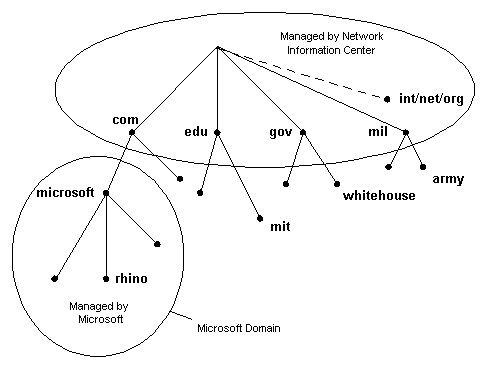
The root of the DNS database on the Internet is managed by the Internet Network Information Center (http://www.internic.com). The top-level domains were assigned organizationally and by country. These domain names follow the International Standard 3166. Two-letter and three-letter abbreviations are used for countries, and various abbreviations are reserved for use by organizations, as shown in the following examples.
|
DNS Domain Name |
Type of Organization |
|
com |
Commercial (for example, microsoft.com for Microsoft Corporation) |
|
edu |
Educational (for example, mit.edu for Massachusetts Institute of Technology) |
|
gov |
Government (for example, whitehouse.gov for the Whitehouse in Washington D.C.) |
|
int |
International organizations (for example, nato.int for NATO) |
|
mil |
Military operations (for example, army.mil for the Army) |
|
net |
Networking organizations (for example, nsf.net for NSFNET) |
|
org |
Noncommercial organizations (for example, fidonet.org for FidoNet) |
Each node in the tree of a DNS database, along with all the nodes below it, is called a domain. Domains can contain both hosts (computers) and other domains (subdomains). For example, the Microsoft domain microsoft.com could contain both computers such as FTP.microsoft.com and subdomains such as dev.microsoft.com which could contain hosts such as ntserver.dev.microsoft.com.
|
In general, Domain names and Host names have restrictions in their naming which only allow the use of characters "a-z", "A-Z", "0-9", and "-" (dash or minus sign). The use of characters such as the "/", ".", and "_" (slash, period, and underscore) are not allowed. |
A zone is some portion of the DNS namespace whose database records exist and are managed in a particular zone file. A single DNS server might be configured to manage one or multiple zone files. Each zone is anchored at a specific domain node—referred to as the zone’s "root domain." Zone files do not necessarily contain the complete tree (that is all subdomains) under the zone’s root domain. For a comparison of domains and zones, look at the figure that follows. In this example, microsoft.com is a domain but the entire domain is not controlled by one zone file. Part of the domain is actually broken off into a separate zone file for dev.microsoft.com. Breaking up domains across multiple zone files might be needed for distributing management of the domain to different groups or possibly for efficiencies in data replication (that is zone transfers which will be discussed later).
|
It is very important that you understand the difference between a zone and a domain. A zone is a physical file composed of resource records that defines a group of domains. A domain is a node in the DNS namespace and all subdomains below it. |
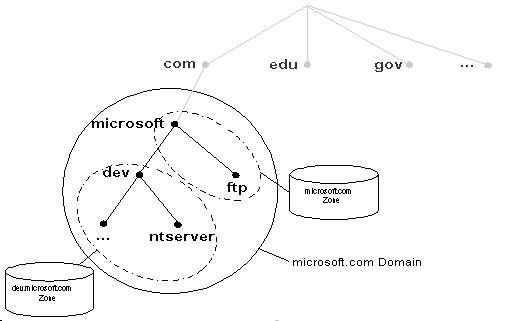
DNS servers store information about the domain name space and are referred to as name servers. Name servers generally have one or more zones for which they are responsible. The name server is then said to have authority for those zones.
When you configure a DNS name server (as we will soon see with the "NS" record), you tell it what are all of the other DNS name servers that are in the same domain.
Primary, Secondary, and Master Name Servers
A primary name server is a name server that gets the data for its zones from local files. Changes to a zone, such as adding domains or hosts, are done at the Primary Name Server. A secondary name server gets the data for its zones from another name server across the network which is authoritative for that zone. The processes of obtaining this zone information (that is the database file) across the network is referred to as a zone transfer.
There are three reasons to have secondary servers within an enterprise. Those reasons are:
You need at least two DNS name servers serving each zone, a primary and at least one secondary for redundancy. Like any fault tolerant system, the machines should be as independent as possible (that is different networks and so forth).
You should also have secondary servers (or other primary servers for subdomains) in remote locations that have a large number of clients. You would not want these clients to have to communicate across slow links for name resolution.
You also need secondary servers to reduce the load on the primary server.
Since information for each zone is stored in separate files, this primary or secondary designation is defined at a zone level. In other words, a particular name server may be a primary name server for certain zones and a secondary name server for other zones.
When defining a zone on a name server as a secondary, you must designate a name server from which to obtain the zone information. The source of zone information for a secondary name server in a DNS hierarchy is referred to as a master name server. A master name server can be either a primary or secondary name server for the requested zone. When a secondary name server starts up, it contacts its master name server and initiates a zone transfer with that server.
|
Use secondary servers as master servers when the primary is overloaded, or when there is a more efficient network path between "secondary to secondary" vs. "secondary to primary." |
When a DNS name server receives a DNS request, it attempts to locate the requested information within its own zone files. If this fails because the server is not authoritative for the domain requested, it must communicate with other DNS name servers to resolve the request. Since, on a globally connected network, a DNS resolution request outside a local zone typically requires interaction with DNS name servers outside of the company on the public Internet, you may want to selectively enable specific DNS name servers in your company to do this wide-area communication.
To address this issue, DNS allows for the concept of forwarders. Specific DNS name servers are selected to be forwarders, and only forwarders are allowed to carry out the wide-area communications across the Internet. All other DNS name servers within the company are configured to use forwarders and are configured with the IP addresses of the DNS name servers designated as forwarders. This configuration is done on a per server basis, not a per zone basis!
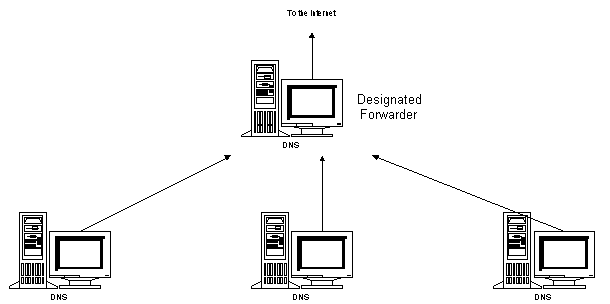
When a server which is configured to use forwarders receives a DNS request that it is unable to resolve (through its own zone files), it passes the request to one of the designated forwarders. The forwarder then carries out whatever communication is necessary to resolve the request and returns the results to the requesting server, which, in turn, returns the results to the original requester. If the forwarder is unable to resolve the query, the DNS server attempts to resolve the query on its own as normal.
Slaves are DNS servers that have been configured to use forwarders and have also been configured to return a failure message if the forwarder is unable to resolve the request. Slaves make no attempt to contact other name servers if the forwarder is unable to satisfy the request.
Although all DNS name servers cache queries that they have resolved, Caching-only servers are DNS name servers whose only job is to perform queries, cache the answers, and return the results. In other words, they are not authoritative for any domains and only contain information which they have cached while resolving queries.
When trying to determine when to use such a server, keep in mind that when the server is initially started it has no cached information and must build up this information over time as it services requests. However, if you are dealing with a slow link between sites then there is much less traffic sent across the slow link because the server is not doing a zone transfer.
There are three types of queries that a client can make to a DNS server, recursive, iterative and inverse. While discussing name resolution, keep in mind that a DNS server can be a client to another DNS server.
In a recursive query, the queried name server is petitioned to respond with the requested data, or with an error stating that data of the requested type doesn’t exist or that the domain name specified doesn’t exist. The name server can not just refer the querier to a different name server.
This type of query is typically done by a DNS client (a resolver) to a DNS server. Also, if a DNS server is configured to use a forwarder, the request from this DNS server to its forwarder will be a recursive query.
In an iterative query, the queried name server gives the best answer it currently has back to the querier. This type of query is typically done by a DNS server to other DNS servers after it has received a recursive query from a resolver.
The following figure shows an example of both types of queries. Query 1/8 is a recursive query from a client resolver to its DNS server while 2/3, 4/5, and 6/7 are iterative queries from the DNS server to other DNS servers.
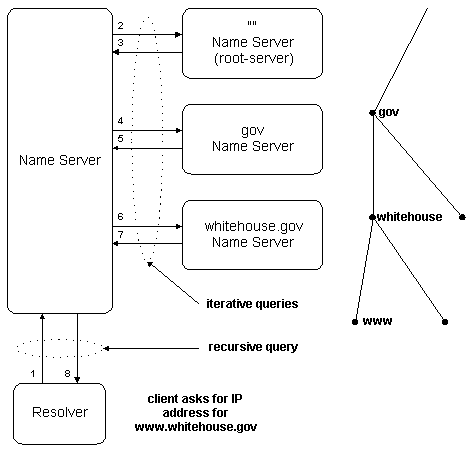
Getting the Host Name Given the IP Address
What if a resolver has the IP Address and would like to know the Host name for a particular machine? Instead of supplying a name and asking for an IP address, the client needs to provide the IP address and asks for the name. Since there is no direct correlation in the DNS name space between the domain names and the associated IP addresses they contain, only a thorough search of all domains could guarantee a correct answer.
To alleviate this problem, a special domain "in-addr.arpa." in the DNS name space was created. Nodes in the in-addr.arpa domain are named after the numbers in the dotted-octet representation of IP addresses. But since IP addresses get more specific from left to right and domain names get less specific from left to right, the order of IP address octets must be reversed when building the in-addr.arpa tree. With this arrangement, administration of lower limbs of the DNS in-addr.arpa tree can be given to companies as they are assigned their class A, B, or C subnet address.
Once the domain tree is built into the DNS database, a special pointer record is added to associate the IP addresses to the corresponding host names. In other words, to find a host name for the IP address 157.55.200.2, the resolver would query the DNS server for a pointer record for 2.200.55.157.in-addr.arpa. If this IP address was outside the local domain, the DNS server would start at the root and sequentially resolve the domain nodes until he reached 200.55.157.in-addr.arpa which should contain the resource PTR record for 2 (that is 157.55.200.2).
When a name server is processing a recursive query, it may be required to send out several queries to find the definitive answer. The name server caches all of the information that it receives during this process for a time which is specified in the returned data. This amount of time is referred to as the Time to Live (TTL). The name server administrator of the zone that contains the data decides on the TTL for the data. Smaller TTL values will help ensure that data about your domain is more consistent across the network if this data changes often. However, this will also increase the load on your name server.
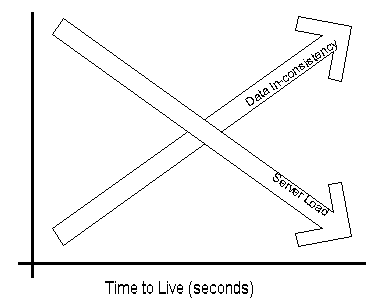
Once data is cached by a DNS server, it must start decreasing the TTL (that is counting down) from its original value so that it will know when to flush the data from its cache. If a query comes in that can be satisfied by this cached data, the TTL that is returned with the data is the current amount of time left before the data is flushed from the DNS server cache. Client resolvers also have data caches and honor the TTL value so that they know when to expire the data.
Most DNS systems must be configured by editing text files. With Microsoft DNS, as with all Microsoft Windows
®-based products, there is a user friendly interface. The new administration interface makes it much easier to configure both local and remote Microsoft DNS servers. The DNS administrative tool configures the RFC-compatible text files for you.Even though the graphical user interface give you the ability to modify the DNS files without an editor, you should know the makeup of the DNS system configuration files. In RFC compliant DNS systems, there are several files which define the DNS system configuration and database. These files include the database, cache, reverse lookup, and 127 reverse lookup files. These files also exist in the Windows NT 4.0 DNS and are also RFC compliant. These files are explained in detail in this section.
A database file or "zone file" is the file which contains the resource records for that part of the domain for which the zone is responsible. Some of the common resource records are given below. For a more complete list, look in the Appendix of this document or refer to the appropriate RFCs. Windows NT 4.0 supplies a file as a template to work with called "place.dns." This file should be edited and renamed before you use it on a production DNS server. It is generally a good idea to name this file the same as the zone it represents. This is the file that will be replicated between masters and secondaries.
The first record in any database file is the SOA Record.
IN SOA <source host> <contact e-mail> <ser. no.> <refresh time> <retry time> <expiration time> <TTL>
|
Instead of writing the "@" symbol in the e-mail name as would normally be done, the "@" must be replaced with a "." when placed in the zone files. In other words, the e-mail address glennwo@microsoft.com would be represented as glennwo.microsoft.com in the zone file. |
In order for a resource record to span a line in a database file, parentheses must enclose the line breaks.
|
In a zone file, the "@" symbol represents the root domain of the zone (microsoft.com in the following examples). The "IN" in the following records is the class of data. It stands for Internet. Other classes exist, but none of them are currently in widespread use. |
|
|
Any domain name in the database file which is not terminated with a period "." will have the root domain appended to the end. |
Example:
@ IN SOA nameserver1.microsoft.com. glennwo.microsoft.com. (
1 ; serial number
10800 ; refresh [3 hours]
3600 ; retry [1hour]
604800 ; expire [7 days]
86400 ) ; time to live [1 day]
Setting the servers refresh interval is a balance between data consistency (accuracy of your data) and your networks load.
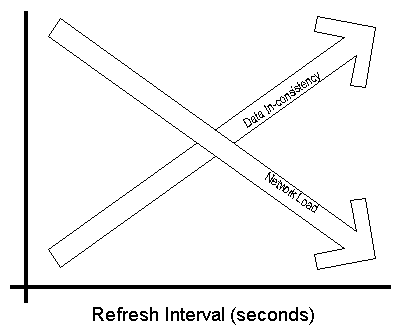
Lists the name servers for this domain allowing other name servers to lookup names in your domain.
<domain> IN NS <nameserver host >
Example:
@ IN NS nameserver2.microsoft.com.
@ IN NS nameserver3.microsoft.com.
This record tells us what host processes mail for this domain. If multiple mail exchange records exist, the resolver will attempt to contact the mail servers in order of preference from lowest value (highest priority) to highest value (lowest priority). By using the example records that follow, mail addressed to scottsu@microsoft.com is delivered to scottsu@mailserver0.microsoft.com first if possible and then to scottsu@mailserver1.microsoft.com if mailserver0 is unavailable.
<domain> IN MX <preference> <mailserver host >
Example:
@ IN MX 1 mailserver0
@ IN MX 2 mailserver1
A host record is used to statically associate hosts names to IP addresses within a zone. It should contain entries for all hosts which require static mappings including workstations, name servers, mail servers, etc. These are the records which make up most of the database file when static records are used.
<host name> IN A <ip address of host>
Example:
rhino IN A 157.55.200.143
nameserver2 IN A 157.55.200.2
mailserver1 IN A 157.55.200.51
A local host record allows lookups for "localhost.microsoft.com." to return 127.0.0.1.
localhost IN A 127.0.0.1
These records are sometimes called "aliases" but are technically referred to as "Canonical Name" (CNAME) entries. These records allow you to use more than one name to point to a single host.
Using canonical names makes it easy to do such things as host both an FTP server and a Web server on the same machine.
<host alias name> IN CNAME <host name>
Example:
Assume that www.microsoft.com and FTP.microsoft.com are on the same machine. If this is the case then you might have the following entries in your zone file:
FileServer1 IN A 157.55.200.41
FTP CNAME FileServer1
www CNAME FileServer1
If you ever intend on moving the FTP server service away from the Web service, then all you have to do is change the CNAME in the DNS server for FTP and add an address record for the new server. For example:
FTP CNAME FileServer2
FileServer2 IN A 157.55.200.42
The cache file contains host information that is needed to resolve names outside the authoritative domains. It contains names and addresses of root name servers. For users on the Internet, the default file provided with the Microsoft DNS Service should suffice. For installations NOT connected to the Internet, the file should be replaced to contain the name servers authoritative for the root of your private network.
For a current Internet cache file see FTP://rs.internic.net/domain/named.cache
Example:
; DNS CACHE FILE
;
; Initial cache data for root domain servers.
;
; YOU SHOULD CHANGE:
; —Nothing if connected to the Internet. Edit this file only when
; update root name server list is released.
; OR
; —If NOT connected to the Internet, remove these records and replace
; with NS and A records for the DNS server authoritative for the
; root domain at your site.
; Internet root name server records:
; last update: Sep 1, 1995
; related version of root zone: 1995090100
;
; formerly NS.INTERNIC.NET
. 3600000 IN NS A.ROOT-SERVERS.NET.
A.ROOT-SERVERS.NET. 3600000 A 198.41.0.4
; formerly NS1.ISI.EDU
. 3600000 NS B.ROOT-SERVERS.NET.
B.ROOT-SERVERS.NET. 3600000 A 128.9.0.107
; formerly C.PSI.NET
. 3600000 NS C.ROOT-SERVERS.NET.
C.ROOT-SERVERS.NET. 3600000 A 192.33.4.12
; formerly TERP.UMD.EDU
. 3600000 NS D.ROOT-SERVERS.NET.
D.ROOT-SERVERS.NET. 3600000 A 128.8.10.90
; formerly NS.NASA.GOV
. 3600000 NS E.ROOT-SERVERS.NET.
E.ROOT-SERVERS.NET. 3600000 A 192.203.230.10
; formerly NS.ISC.ORG
. 3600000 NS F.ROOT-SERVERS.NET.
F.ROOT-SERVERS.NET. 3600000 A 39.13.229.241
; formerly NS.NIC.DDN.MIL
. 3600000 NS G.ROOT-SERVERS.NET.
G.ROOT-SERVERS.NET. 3600000 A 192.112.36.4
; formerly AOS.ARL.ARMY.MIL
. 3600000 NS H.ROOT-SERVERS.NET.
; End of File
This is a database file that is used for reverse-lookups in particular IP DNS zones of host names when supplied with the IP numbers. This allows a resolver to provide an IP address and request a matching host name. This file contains SOA and name server records similar to other DNS database zone files. It also contains pointer records.
This DNS reverse-lookup capability is important because some applications provide the capabilities to implement security based on the connecting host names. For instance, if a client tries to link to a Network File System (NFS) volume with this security arrangement, the NFS server would contact the DNS server and do a reverse-name lookup on the clients IP address. If the host name returned by the DNS server is not in the access list for the NFS volume or if the host name was not found by DNS, then the NFS mount request would be denied. This reverse-lookup capability is often used for troubleshooting reasons as well, which will be discussed later in this document.
Here are a couple example zones for different IP class networks.
Example class C zone:
100.200.192.in-addr.arpa
Example class B zone:
55.157.in-addr.arpa
Pointer records provide a static mapping of IP addresses to host names within a reverse-lookup zone. IP numbers are written in backward order and "in-addr.arpa." is appended to the end to create this pointer record. As an example, looking up the name for "157.55.200.51" requires a PTR query for the name "51.200.55.157.in-addr.arpa."
<ip reverse domain name> IN PTR <host name>
Example:
51.200.55.157.in-addr.arpa. IN PTR mailserver1.microsoft.com.
This is a database file for the 127.in-addr.arpa. domain. This domain is used for reverse-lookups of IP numbers in the 127 network, such as "localhost." The only thing in this file that changes is the SOA and NS records.
Although the boot file is not actually defined in the RFCs and is not needed in order to be RFC compliant, it is described here for completeness. This file is actually a part of the BIND specific implementation of DNS. Microsoft DNS can be configured to use a boot file if you are going to administer it through changes to the text files instead of using the DNS Administrator UI.
This file controls the startup behavior of the DNS server. Commands must start at the beginning of a line and no spaces may precede commands. Recognized commands are: "directory, cache, primary, and secondary." The syntax for this file is as follows:
Specifies a directory where other files referred to in the boot file can be found.
directory <directory>
Example:
directory c:\winnts\system32\dns
Specifies a file used to help the DNS service contact name servers for the root domain. This command and the file it refers to MUST be present. A cache file suitable for use on the Internet is provided with Windows NT 4.0.
cache . <filename>
Example:
cache . cache
Specifies a domain for which this name server is authoritative and a database file which contains the resource records for that domain (that is zone file). Multiple primary command records could exist in the boot file.
primary <domain> <filename>
Example:
primary microsoft.com microsoft.dns
primary dev.microsoft.com dev.dns
Specifies a domain for which this name server is authoritative, and a list of master server IP addresses from which to attempt downloading the zone information, rather than reading it from a file. It also defines the name of the local file for caching this zone. Multiple secondary command records could exist in the boot file.
secondary <domain> <hostlist> <local filename>
Example:
secondary test.microsoft.com 157.55.200.100 test.dns
Specifies another server that is willing to try resolving recursive queries on behalf of the system.
forwarders <hostlist>
Example:
forwarders 157.55.200.100 157.55.200.101
Specifies that the use of forwarders is the only possible way to resolve queries. Can only follow a forwarders command.
slave
Example:
forwarders 157.55.200.100 157.55.200.101
slave
Implementing DNS using Windows NT 4.0
You can use Microsoft DNS if you want to replace UNIX DNS servers with Windows NT-based systems or if you need to integrate WINS enabled Microsoft-based clients and servers into a UNIX-based environment.
Some people might ask, what is the Microsoft DNS and why should I use it? Well let’s start out by telling you what it is not. First, the Microsoft DNS server is not a port of the Berkley BIND code (which is currently at revision 10.4 as of the writing of this paper). We made a conscious decision to not port the BIND code, but rather write our own code that was fully RFC compliant and compatible with BIND. We made this decision because we wanted to be able to easily add performance enhancements to the product. The Microsoft DNS server is also not the code that was shipped in the Windows NT Resource Kit. If you used that utility, you probably noticed that it had problems with zone transfers. The DNS server service in Windows NT 4.0 is a complete rewrite and is not just a bug-fixed version. Rest assured that in the DNS included with
Windows NT 4.0, RFC compliance has been thoroughly tested and it all
works as defined, including zone transfers.
Now let’s talk about what the Microsoft DNS server is. First and foremost, the DNS server in Windows NT 4.0 is an RFC compliant implementation of DNS. If there is a required feature in an RFC that is not found in the Microsoft DNS product, this would be considered a bug.
Because Microsoft DNS is an RFC compliant DNS server, it creates and uses standard DNS zone files and supports all standard resource record types. It is interoperable with other DNS servers and includes the defacto standard DNS diagnostic utility—NSLOOKUP. Microsoft DNS also has many features above and beyond those specified in the RFCs, such as dynamic update through tight integration with WINS and easy administration through the graphical administration utility called DNS Manager.
|
Microsoft DNS supports RFCs 1033, 1034, 1035, 1101, 1123, 1183and 1536 |
With the Microsoft implementation of DNS, network administers can turn off the legacy DNS systems in favor of a Microsoft Windows NT implementation. They can remove any static entries for Microsoft-based clients in legacy DNS server zone files in favor of the dynamic WINS/DNS integration. For example, if a non Microsoft-based client wants to get to a Web page on an HTTP server that is DHCP/WINS enabled, the client can query the DNS server, the DNS server can query WINS, and the name can be resolved and returned to the client. Previous to the WINS integration, there was no way to reliably resolve the name because of the dynamic IP addressing.
The following figure shows how a non-Microsoft-based client might find a machine named "scottsu1.microsoft.com" which is running Microsoft Internet Information Server (IIS) which has a dynamically allocated address from DHCP and which has registered with WINS.
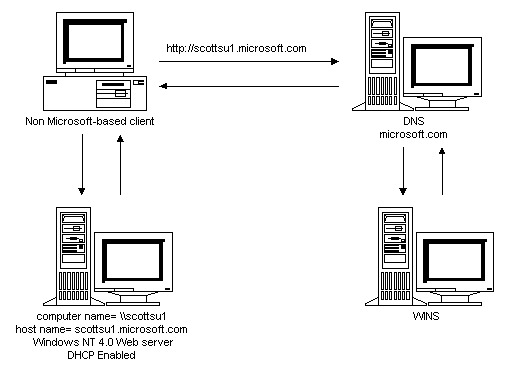
Also, as mentioned previously, the server running Microsoft DNS has a graphical user interface DNS Manager that allows for easy administration of any other Microsoft DNS server on the network via RPC (similar to the way other Windows NT administrative utilities such as Server Manager and Event Viewer work). The administrative UI also contains a zone wizard that enables someone less familiar to DNS to be successful in creating zones and zone database files. Keep in mind that you cannot administer non-Microsoft DNS servers with this administrative tool.
It’s important to note that the Microsoft DNS server can easily use the database, boot, cache, rev and other files from any other DNS server implementation (that is UNIX or other Windows NT DNS implementation) as long as that DNS server is RFC compliant. All that needs to be done to port the files over to Microsoft DNS is to change the file names and locations in the boot file.
|
Although Microsoft DNS will support a boot file on initial installation, the Boot file is a BIND specific implementation and not a requirement of the RFCs. This feature is provided for easy migration from BIND-based DNS Servers. If the Microsoft DNS Manager UI tool is used to create and administer zone files, this "Boot From BootFile" option will be set to "Boot From Registry" and Microsoft DNS will store and use data in the |
The Microsoft DNS server can also be a primary or secondary to any other operating system (or other vendors Windows NT implementations). This makes it easy to begin to migrate away from a UNIX DNS-based solution to the Microsoft-based solution.
The next section will walk you through the setup of a Microsoft DNS server and explain the parameters required for a client resolver to work.
Verify DNS Information in Windows NT
Before installing the actual Microsoft DNS service, it is important that the Windows NT Server 4.0 server’s TCP/IP stack is configured correctly. In particular, the DNS section needs to be verified since the DNS service gets many of its default settings from this section during setup.
To verify this information, run Control Panel and go into Network. Click the Protocols tab. Pull up the properties dialog box for the TCP/IP Protocol and click the DNS tab. Verify that you have a correct Host Name and Domain filled in on this screen.
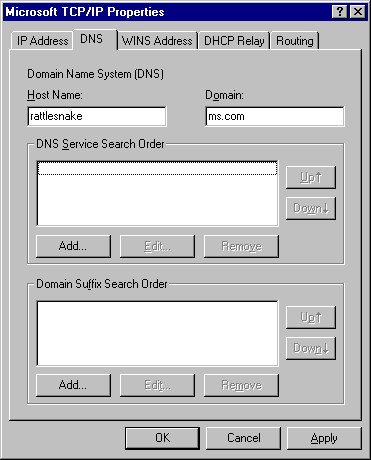
|
If the domain name and host name are supplied in the network control panel setup when you create a zone, DNS will add an SOA, A, and NS record to the database. If the information is not configured then only the SOA record is created. |
Installing the Microsoft DNS Service
To install the Microsoft DNS Service on a Windows NT 4.0-based system, run the Control Panel and go into Network. Click the Services tab and click the Add button. Highlight Microsoft DNS Server and click OK.
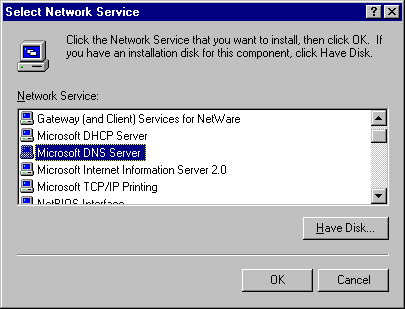
At this point, a default installation of Microsoft DNS server service will be installed on the Windows NT-based server. This installation will install files in your \<SystemRoot>\system32\Dns directory as shown. At this point you will be prompted to restart your server.


Configuring DNS Domains and Zones
To configure the DNS server, run the DNS Manager under the Administrative Tools. Initially, the DNS Manager will not have any servers in its list. To add the local server, pull down the DNS menu and click New Server. Fill in the name of your local server and click OK. The server will then show up in the Server List. Double-click on the server to see the server statistics and zones that have been defined.
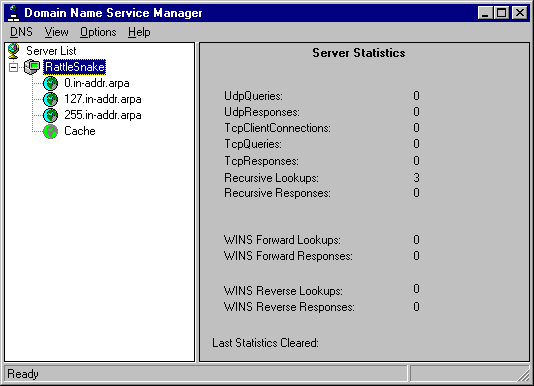
Since initially, the DNS server has no information about your specific network, the DNS server service installs as a caching-only name server for the Internet. This means that DNS only contains information on the Internet root servers. For most DNS configurations, additional information must be supplied to obtain the desired operation.
The first step in configuring the DNS server is to determine the hierarchy for your DNS domains and zones. Design considerations for a DNS hierarchy are discussed in the next section of this paper. Once the domain and zone information has been determined, this information must be entered into the DNS configuration using the DNS Manager.
Since DNS information is grouped and controlled by zones, a zone must first be created. To do this, click the server name with the alternate mouse button and then click New Zone.
|
If you double-click on the CACHE zone, you can see all of the hosts that the DNS server has statically defined and dynamically cached due to a previous query. The CACHE will also show all of the WINS entries that have been resolved and have not elapsed their WINS specific Cache Time-out Value. |
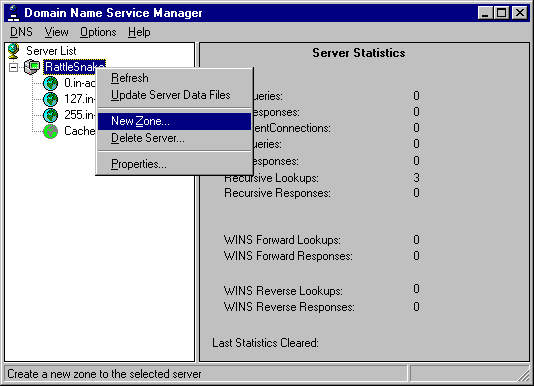
At this point, a dialog is presented which ask if the zone you are creating is a primary zone (information stored locally) or a secondary zone (information obtained from a master server via a zone transfer). If it is a primary zone, no additional information is needed at this step. If it is a secondary zone, you must also enter the zone and master server names in this screen.
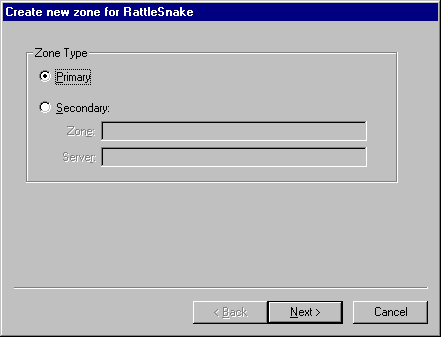
The next step is to fill in the zone name and zone file information for the local server. This will determine how the zone shows up in the DNS Manager and what file name it is stored under. If this is a secondary zone, this zone name should match the master server zone name. If this zone file already exists in the DNS directory, DNS will import these records automatically when this zone is created.
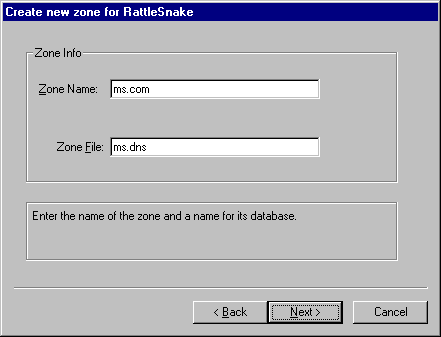
If this is a secondary zone, you would then be asked to enter the IP address of the master name servers (the name servers with which you will do zone transfers for this zone).
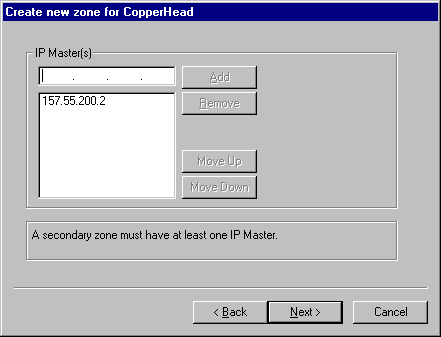
Once all this information is entered, the zone will be added to the DNS hierarchy. If you have additional zones that need to be added, follow the same procedure for each of them. Once all zones have been added to the server, you should then add any DNS subdomains under the zones that your hierarchy might contain. To do this, click the appropriate zone with the alternate mouse button and click New Domain.
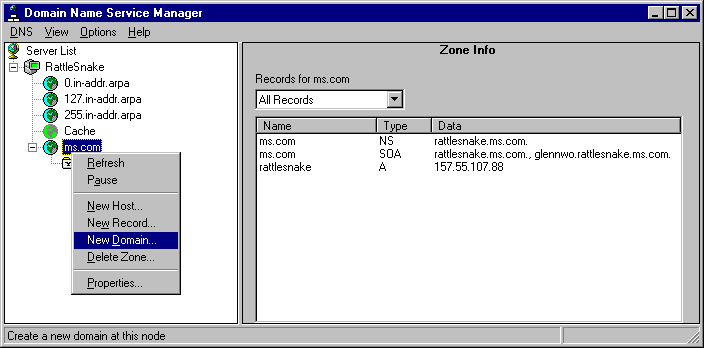
Enter the name of the new subdomain in the dialog box and click OK. If multiple levels of subdomains are needed, create each successive sub-domain by clicking on the immediate parent with the alternate mouse button, clicking on New Domain, and entering the name of the new subdomain.
This process can also be used for adding new host or resource records at any domain location within the DNS hierarchy.
Although DNS may seem similar to Windows Internet Naming Service (WINS), there are a couple of major differences. DNS is a static database of IP addresses for name-to-address mapping which must be manually updated by an administrator. Also, DNS has the concept of hierarchy which allows the administration and replication of the database to be broken up into "zones." WINS, on the other hand, allows machines to dynamically register their name-to-address mappings and therefore requires far less administration. WINS is also a flat name space, without the concept of hierarchy and requires each WINS server to maintain a complete database of entries through replication.
The Microsoft DNS server works hand in hand with the Microsoft WINS server and provides a great deal of interoperability. To provide this interoperability, a new record was defined as part of the zone database file. The WINS record is specific to Windows NT and may be attached only to the zone root domain. The presence of a WINS record instructs the name server to use WINS to lookup any requests for hosts in the zone root which do not have static addresses in the IP database. This functionality is particularly useful for UNIX-based clients that need to contact DHCP/WINS enabled clients via IP.
<domain> IN WINS <IP address of WINS server>
Example:
@ IN WINS 157.55.200.81
WINS Lookup can be enabled for a zone through the DNS Manager instead of requiring manual entry of the WINS record. This is accomplished by clicking the zone with the alternate mouse button and clicking properties. Then click the WINS Lookup tab. Check the Use WINS Resolution checkbox and fill in the IP address of the WINS Server that you wish to use and click Add. Multiple WINS server addresses can be entered.
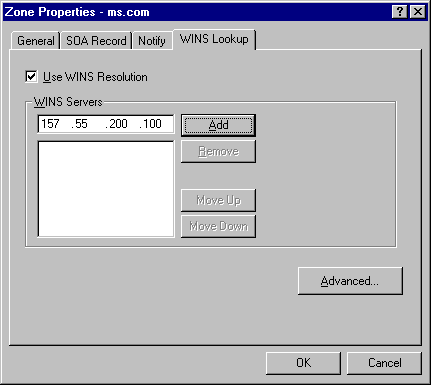
You probably only need to use WINS lookup, if you have non-Microsoft-based TCP/IP clients that need to resolve Host Name to IP addresses. For example, if there is a need in your organization to be able to use FTP or HTTP on your servers running Windows NT from non-Microsoft-based (that is UNIX) clients.
|
|
If you have a zone configured to do WINS lookup, then all DNS servers that are authoritative for that zone need to be able to do WINS lookup or you will have intermittent behavior. |
In order to easily add the Microsoft WINS / DNS lookup to a legacy DNS architecture, simply create a new DNS subdomain in your enterprise and have the Windows NT-based primary and secondary servers enabled to do WINS lookup in this domain. For example, in the following figure there is an acme.com domain and a Msdomain.acme.com domain. All of the Microsoft-based clients register with the WINS server in the Msdomain.acme.com domain.
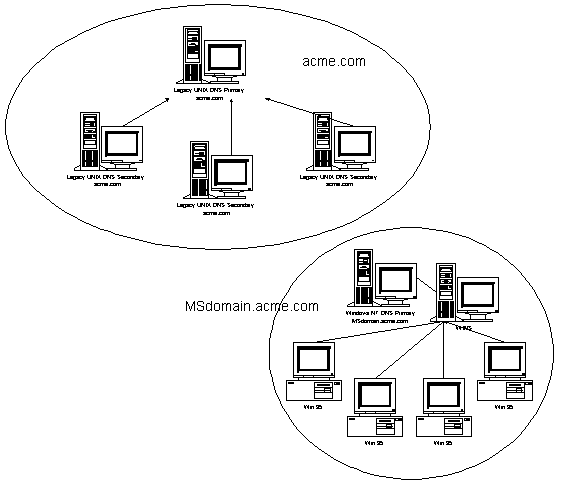
WINS lookup is done on a DNS-zone basis. So a query to a DNS server for scottsu1.microsoft.com would go to the WINS server if the DNS that had the WINS lookup record was authoritative for zone microsoft.com, but a query for scottsu1.dallas.microsoft.com would not go to that same WINS server. This is shown in the following figure.
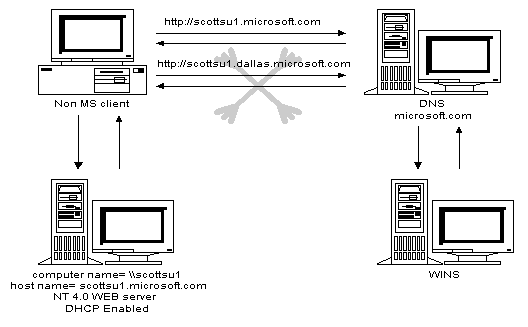
If you are using a WINS record the Time to Live (TTL) in the SOA record is not the default for WINS as well, the WINS TTL is configured via the "Advanced Zone Properties" dialog box (under the WINS lookup tab) when your configuring the zone. When an IP address / Host name gets resolved via WINS the address is cached for the WINS Cache Time-out Value. If this address is ever forwarded to another DNS the WINS Cache Time-out Value TTL is what is sent.
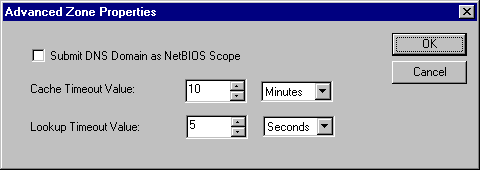
If your data doesn’t change much then you will want to set your TTL high. Keep in mind that you can set the TTL on individual records as well.
|
If the TTL on an individual RR’s address is lower or higher than the TTL in the SOA record the individuals TTL takes precedence. |
The WINS Reverse Lookup Record
Although WINS was not constructed to provide reverse lookup capabilities, this functionality can still be accomplished for DHCP/WINS enabled clients when using Microsoft’s DNS server. The presence of a WINS-R record at the zone root instructs the name server to use a NetBIOS node adapter status lookup for any reverse lookup requests for IP addresses in the zone root which are not statically defined with PTR records.
<domain> IN WINS-R <domain to append to returned NetBIOS names>
Example:
@ IN WINS-R microsoft.com.
WINS Reverse Lookup can be enabled for a zone through the DNS Manager instead of requiring manual entry of the WINS-R record. This is accomplished by clicking on the appropriate in-addr.arpa zone with the alternate mouse button and clicking on properties. Then click on the WINS Reverse Lookup tab. Check the Use WINS Reverse Lookup checkbox and fill in the DNS Host Domain to be appended to the NetBIOS name before returning the response to the resolver.
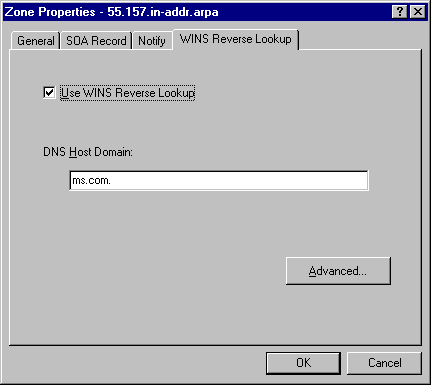
|
The Microsoft DNS server can be configured to NOT send WINS records to secondary servers. This is necessary if you have a mixture of Microsoft- and UNIX-based DNS servers since UNIX-based DNS servers do not have the capability to do WINS lookup. |
The Microsoft DNS server supports "Notify"
The DNS NOTIFY transaction allows master servers to inform secondary servers when the zone has changed (notify is set on the master server on a per zone basis)—an interrupt as opposed to poll model. This should reduce propagation delay while not unduly increasing the master server’s load.
The use of this feature depends on how often the master server’s data will change and how slow the link is between the secondary and the primary. If the master server’s data changes a great deal, and it is important that the data on the secondaries is very accurate, and the link between the site that houses the primary and the secondary is not negatively impacted by the zone transfer, then it may be a good idea to use this feature.
It’s also a good idea to use this feature if the master server’s data does not change very often. If this is the case then you can make the refresh time on the master very long and a notification will be sent to the secondaries when they need to update their zone database.
Microsoft DNS supports "Round Robin"
Round Robin is a technique used as a form of load balancing between servers. You can read more about load balancing in RFC 1794. Here’s an example that shows how this works:
On the DNS server you could have 2 address entries for the same host, such as the following:
copperhead.glennwo.scottsu.com A 157.55.106.193
copperhead.glennwo.scottsu.com A 157.55.107.88
If you make a query via some mechanism such as "PING copperhead.glennwo.scottsu.com," the DNS server will send both IP addresses back, but typically the client will always use the first one. The next time the DNS server receives a query for this host the order of the list is changed in a round robin fashion (the address that was first in the previous list will be last in the new list), hence when the client resolver chooses the first IP address in the list, it chooses a different server. This is typically used for load balancing.
Here is a trace of a query that shows how the feature works. In frame 1 a query is sent to get the IP address for host "copperhead.glennwo.scottsu.com". Since there were 2 entries in the database, both were returned. The client resolver, in most implementations (including the Microsoft resolver) uses the first entry and discards the other.
1 SCOTTSU-7 Xircom40417A DNS 0x1:Std Qry for copperhead.glennwo.scottsu.com
DNS: 0x1:Std Qry for copperhead.glennwo.scottsu.com of type Host Addr on class INET addr.
2 Xircom40417A SCOTTSU-7 DNS 0x1:Std Qry Resp. for copperhead.glennwo.scottsu.com
DNS: 0x1:Std Qry Resp. for copperhead.glennwo.scottsu.com of type Host Addr on class INET addr.
....
DNS: Answer section: copperhead.glennwo.scottsu.com of type Host Addr on class INET addr.(2 records present)
DNS: Resource Record: copperhead.glennwo.scottsu.com of type Host Addr on class INET addr.
DNS: Resource Name: copperhead.glennwo.scottsu.com
DNS: Resource Type = Host Address
DNS: Resource Class = Internet address class
DNS: Time To Live = 0 (0x0)
DNS: Resource Data Length = 4 (0x4)
DNS: IP address = 157.55.107.88
DNS: Resource Record: copperhead.glennwo.scottsu.com of type Host Addr on class INET addr.
DNS: Resource Name: copperhead.glennwo.scottsu.com
DNS: Resource Type = Host Address
DNS: Resource Class = Internet address class
DNS: Time To Live = 3600 (0xE10)
DNS: Resource Data Length = 4 (0x4)
DNS: IP address = 157.55.106.193
The next time someone makes a query for the host copperhead.glennwo.scottsu.com the first IP address in the list will be different.
DNS: Answer section: copperhead.glennwo.scottsu.com of type Host Addr on class INET addr.(2 records present)
DNS: Resource Record: copperhead.glennwo.scottsu.com of type Host Addr on class INET addr.
DNS: Resource Name: copperhead.glennwo.scottsu.com
DNS: Resource Type = Host Address
DNS: Resource Class = Internet address class
DNS: Time To Live = 3600 (0xE10)
DNS: Resource Data Length = 4 (0x4)
DNS: IP address = 157.55.106.193
DNS: Resource Record: copperhead.glennwo.scottsu.com of type Host Addr on class INET addr.
DNS: Resource Name: copperhead.glennwo.scottsu.com
DNS: Resource Type = Host Address
DNS: Resource Class = Internet address class
DNS: Time To Live = 0 (0x0)
DNS: Resource Data Length = 4 (0x4)
DNS: IP address = 157.55.107.88
The main thing to remember about DNS support for NetBIOS scope is DON’T USE IT unless your network already uses NetBIOS scope. In a scope configuration, all hosts are assigned a scope ID, and they register this scope ID—along with their NetBIOS name with WINS. If DNS is configured to use scope, when it queries WINS, in addition to passing the DNS host name as the single-part NetBIOS name, it also passes the DNS domain as the NetBIOS scope ID.
A very important point to remember about scope is that when scope is used, NetBIOS applications can not see hosts that are in another scope! One such NetBIOS application happens to be the Windows NT Netlogon service which is responsible for trust relationships between Windows NT domains. This means, for example, that if scope is used a user cannot logon in a domain whose domain controllers have a different scope than that of the users station. It also means that a user cannot access resources on a network server in a domain whose scope is different than that of the users station.
When does Microsoft DNS read and write to the zone files?
On startup of the DNS service, the zone files are read from disk. As changes are made through the DNS Manager, the service periodically flushes these changes to disk. In general, you should always use the DNS Manager utility to add, delete, or modify resource records in the database, however if you feel a need to modify the files with an editor, you should only make changes to these files if the DNS server service is stopped. By default, the files are located in \%SystemRoot%\system32\Dns.
If you use the DNS administrative utility, and choose the DNS | "Update Server Data Files" menu item, the files will also be flushed from memory to disk.
The DNS server will report events into the Eventlog. This allows an administrator to determine when a zone transfer has been completed, or when the DNS service has started, stopped or an error has occurred.
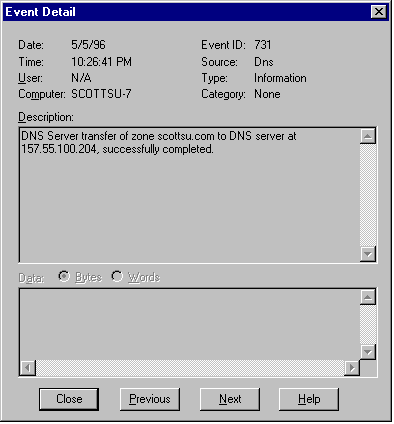
The exact procedure needed to setup individual client machines will vary depending on the operating system and TCP/IP software being used. The specific procedures for the clients will not be covered in this paper, however, the general setup parameters required and their use will be discussed.
The host name for the client can be any combination of the letters A through Z, the numerals 0 through 9, and the hyphen (-). By default, in Microsoft networking environments, this value is the NetBIOS computer name, but you can assign a different host name without affecting the NetBIOS computer operation if desired. If WINS Lookup is used with Microsoft DNS, this value should match your NetBIOS computer name for consistency.
|
Some characters that can be used in NetBIOS names, especially the underscore and period, cannot be used in DNS host names. |
The domain name is used with the host name to create a fully qualified domain name (FQDN) for the computer. The FQDN is the host name followed by a period (.), followed by the domain name. For example, this could be wkstn1.microsoft.com, where wkstn1 is the host name and microsoft.com is the domain name. During DNS queries, the fully qualified domain name is used.
Many operating systems allow you to specify several DNS servers in their configurations. When this capability is provided, a priority order is also provided so that a preferred server can be identified. For a given DNS query, the system attempts to get DNS information from the first IP address in the list. If no response is received, it goes to the next server in the list, and so on.
|
In most systems, if you have two DNS servers listed, the system only checks the second server if no response is received from the first server. If the system attempts to check a host name with the first server and receives a message that the host name is not recognized, the system does not try the second DNS server. |
The Domain Suffix Search Order
In some systems, a Domain Suffix Search Order capability is provided. The Domain Suffix Search Order specifies the DNS domain suffixes to be
appended to the host names during name resolution. When attempting to resolve a fully qualified domain name (FQDN) from a host only name, the system will first append the local domain name. If this is not successful, the system will use the Domain Suffix list to create additional FQDNs in the order listed and query DNS servers for each.
An example client configuration from a machine running Windows NT 4.0 is illustrated below.
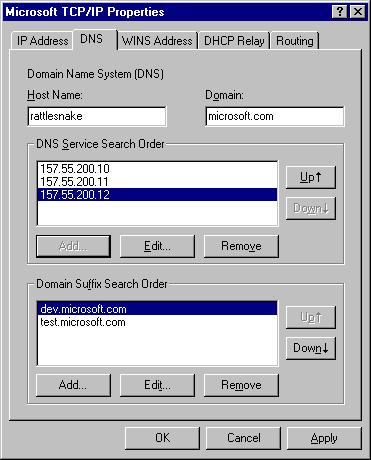
Windows NT TCP/IP 3.5x systems may use several methods for locating NetBIOS resources:
Earlier implementations used only cache, broadcasts, and LMHOSTS files; however, in version 3.5, a NetBIOS name server (WINS) was added, and modifications were made to allow NetBIOS applications to query the DNS name-space by appending configurable domain suffixes to a NetBIOS name. However, the DNS name resolution was always done last after the NetBIOS cache, LMHOSTS file (if enabled), WINS (if enabled), and broadcast were tried. With Windows NT 4.0 the DNS name resolution will be tried first if the name is greater than 15 characters (maximum length of a NetBIOS computer name on Windows NT). The Host name can now be used in any of the
Windows NT utilities (such as Microsoft Explorer seen below) that previously supported NetBIOS computer names. This functionality will also be made available in the Windows
|
Remember that the \%SystemRoot%\system32\drivers\etc\HOSTS file can still be used for Host name resolution. However, DNS will be queried before the HOSTS file is parsed. If the DNS Host name (larger than 16 characters) is passed to a utility and there are 2 transports loaded on a workstation (TCP and NetBEUI), only the TCP transport will try to setup the session. If the Host name is not used and the NetBIOS name is used then all transports will be tried. |

In this example I could have also used:
\\157.55.100.204\public instead of \\scottsu-7.scottsu.com\public.
For more information on NetBIOS name resolution you can refer to the White Paper titled, "Microsoft Windows NT Server 3.5—NT203 Administration Tools of Windows NT Advanced ServerDynamic Host Configuration Protocol and Windows Internet Naming Service," part number 098-56544.
|
On a Windows NT-based workstation, if a Host name is not found via DNS resolution, the name will be passed to NetBT (NetBIOS over TCPIP) for resolution via WINS, LMHOSTS file or broadcast. This might be seen as a feature for intranets that have many Web or FTP servers and want to get resolution via WINS for host queries. Prakash Narasimhamurthy of Microsoft Consulting Services provided the flow charts shown in the following figures to illustrate name resolution for the various node types. |
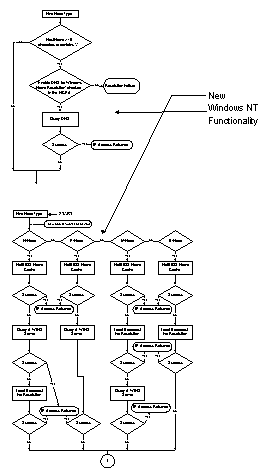
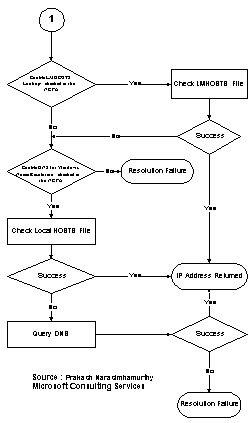
Nslookup will probably be one of your primary diagnostic tools when debugging a Domain Name System (DNS) architecture. It can be used to display any resource record on any DNS server including UNIX-based DNS implementations. NSLookup from most other DNS implementations should also work against the Microsoft-based DNS server. This is a command line utility and has the following syntax.
nslookup [[-option ...] [computer-to-find]] | - [server]
Nslookup has two modes: interactive and non-interactive.
If you only need to look up a single piece of data, use non-interactive mode. For the first argument, type the name or IP address of the computer to be looked up. For the second argument, type the name or IP address of a DNS name server. If you omit the second argument, the default DNS name server will be used.
If you need to look up more than one piece of data, you can use interactive mode. Type a hyphen for the first argument and the name or IP address of a DNS name server for the second argument, or omit both arguments and the default DNS name server will be used.
-option . ..
You can specify one or more nslookup commands as a command-line option. For a list of commands, see "Nslookup Commands" in the WINNT.HLP file supplied with Windows NT 4.0. Each option consists of a hyphen (-) followed immediately by the command name and, in some cases, an equal sign (=), and then a value. For example, to change the default query type to host (computer) information and the initial timeout to 10 seconds, you would type:
nslookup -querytype=hinfo -timeout=10
The command line length must be less than 256 characters.
computer-to-find
This instruct Nslookup to Look up information for computer-to-find using the current default server or using server if specified. If computer-to-find is an IP address and the query type is A or PTR, the name of the computer is returned. If computer-to-find is a name and does not have a trailing period, the default DNS domain name is appended to the name. (This behavior depends on the state of the set options: domains, srchlist, defname, and search.) To look up a computer not in the current DNS domain, append a period to the name.
If you type a hyphen (-) instead of computer-to-find, the command prompt changes to Nslookup interactive mode.
server
Use this server as the DNS name server. If you omit server, the default DNS name server is used.
For more information on the Windows NT Nslookup utility, check the WINNT.HLP file supplied with Windows NT 4.0.
Weaknesses of Current Implementation
Inefficient Reverse Lookup (NbtStat)
DNS and WINS integration does not enable efficient DNS "reverse lookup." Both the DNS server and the host being located are involved when a reverse lookup is requested for a WINS client since the DNS server does a NetBIOS node adapter status lookup to resolve this IP address to a name. If DNS dynamic update was a released RFC and was used instead of WINS integration, reverse lookup would be more efficient and involve only the DNS servers.
Non Microsoft-Based Hosts don’t Register with WINS
Non-Microsoft-based hosts do not register in WINS and therefore can not "dynamically register" in DNS. If true DNS dynamic update was supported by Microsoft’s DNS server, non-Microsoft-based hosts, that supported dynamic DNS, would be able to register in the Microsoft DNS and Microsoft-based hosts could dynamically register in non-Microsoft DNS that supported the DNS dynamic update standard.
WINS registration is not secure and it would be difficult to make it secure. The IETF is working to complete a standard for adding security to DNS dynamic update. The DNS security standard in not scheduled to enter IETF standards track until the fourth quarter of 1996.
DNS and WINS Integration is not an RFC
Though DNS dynamic update is not yet an IETF standard, some implementations already exist. Microsoft has chosen to wait until this is standardized in order to minimize impact on our customers if changes were made before the standard was released.
While WINS is actually based on IETF standards (RFC 1001, 1002), its NetBIOS "roots" have resulted in very limited acceptance by IETF and the UNIX community. The DNS and WINS integration is not standards based and is therefore not accepted.
There is currently no way to programmatically query the DNS database other than gethostbyname(). It is currently not possible to do things such as programmatically query the DNS for an MX record.
DNS is going to be an important part of the Enhanced Directory Services architecture in the next major revision of Windows NT Server, so it is important to design a DNS architecture that allows for a smooth transition/migration.
Using the Microsoft DNS Server to Connect to the
Internet
Many corporations today are wanting to connect their internal networks to the Internet to provide access to these external resources to employees who need them to accomplish their assigned tasks. Although this is a very important capability, it is one that must be well planned to avoid possible data security risk from exposing the internal network to users outside the corporation. One common way to provide this protection is with the use of a firewall. In Internet terms, a firewall is a system or device which provides network security by allowing only certain authorized activities to be accomplished between internal networks and the Internet.
A firewall system can be very simple or extremely complex depending on the particular requirements of the individual company. This paper is not designed to provide an exhaustive description of firewall design but we will briefly discuss how the Microsoft DNS server can be used in a firewall environment.
Here is a typical Internet connectivity setup for a company using a dual-homed firewall (that is proxy).
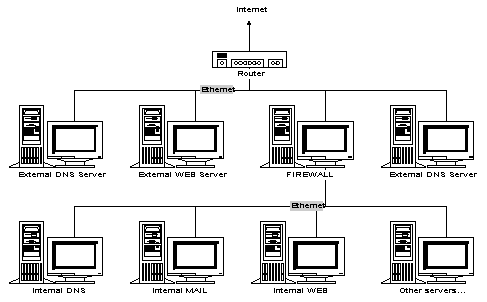
The firewall protects access from the outside while allowing clients on the internal network access to Internet resources. This design also allows for external WWW and FTP servers. These external servers must be closely monitored and secured as much as possible since they are directly on the Internet network with no "firewall" type access control. The router can provide some security by providing packet filtering, if desired, to limit the type of traffic allowed. Access to the internal network is controlled by the firewall.
The internal Web server can be setup exactly like the external server except that security concerns are limited to the access controls necessary for company employees. Typically, only those responsible for Web development will actually logon to the internal servers to change the files located there, although everyone would typically be given the right to view the Web pages using a browser.
The Domain Name System for the external and internal networks are usually entirely isolated from one another. This prevents external clients from obtaining the names and addresses for internal resources located inside the firewall. The only thing an outside user will see is the IP addresses of the servers which are providing external services (that is FTP, www, mail, and so on).
Typical Internet Connectivity Design
With these security concerns now established, let’s look at a typical Internet connectivity design and specifically at the way the DNS servers would be configured. Below is a diagram of a typical large company which has several internal and external resources which require DNS services.
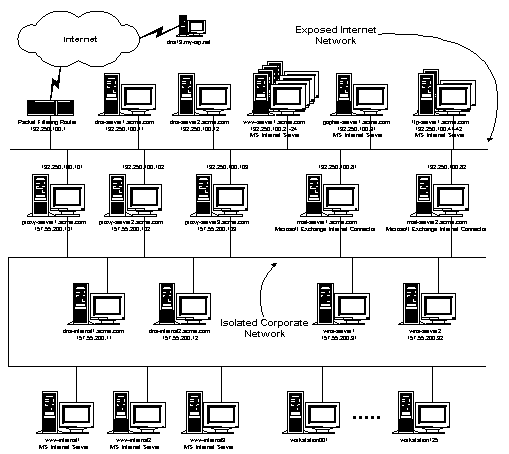
There are several items which should be noted about this example network before we begin discussing the DNS configurations. These items are:
With these details in mind, let’s look at how this would affect the DNS
architecture. We will go through the thought process of configuring the external DNS server first and then we will discuss the internal DNS server.
External DNS Server Configuration
After installing the DNS service on the Windows NT Server-based machines (that is dns-server1 and dns-server2), we use the Microsoft DNS Manager tool to create a primary zone for domain acme.com and a reverse lookup primary zone for 100.250.192.in-addr.arpa on dns-server1. This will create an SOA record which contains the primary name server "dns-server1.acme.com." and the e-mail address for the administrator of the DNS server "web-master@acme.com" as well as a separate NS record for dns-server1. Since the remaining default parameters for this zone are sufficient, we will not modify them and the defaults will be placed in the SOA record.
The following additional records must be created in the acme.com domain and should be done with the "Create Associated PTR Record" enabled where applicable.
Name server records (NS) should be created for dns-server2 and dns13.my-isp.com. Mail exchange records (MX) should be created for mail-server1 and mail-server2. We will set the preference for both of these to 10 for equal load balancing. Address records (A) should be created for each of the computers which connect directly to the "Exposed Internet Network."
The actual name of the gopher server in our example is "gopher-server1.acme.com". The "defacto" standard for supplying services on the Internet is to serve them on computers with host names that correspond with the service being supplied. To allow users to easily locate our gopher service by connecting to the standard "gopher.acme.com", we will use a canonical name (that is alias) for this server. To do this, we create a canonical name record (CNAME) for "gopher" and associate it with "gopher-server1".
Since there are multiple mirrored web servers and FTP servers providing services to external users, there needs to be a way of grouping these so that load balancing across the servers can occur. There are several ways to do this with "round robin" techniques. The method which we will use here is to associate each of the mirrored servers with the same alias name. We will use the popular names of the services as the alias (that is www, FTP, etc.) which will allow easier location of the services by users. To do this, we create a canonical name record (CNAME) for each of the mirrored servers with the service name as the alias and the server name for the host. With this arrangement, each query to a particular DNS server for a particular server name using its alias (that is www.acme.com), will return the list of servers in a "round robin" fashion with a different server being listed first in the list each time. Since most resolvers try the first returned entry first, as described previously in this paper, this will provide load balancing between servers.
Once this zone has been setup on the primary DNS server, the acme.com and 100.250.192.in-addr.arpa zones should be created on the secondary DNS servers. These secondary zones should be pointing back to the primary DNS server as the master for the zone transfers.
Here is the resulting zone file for the external DNS servers:
;-----------------------------------------------------------------------------------
;
; Database file acme.dns for acme.com. zone. (External DNS Server)
; Zone version: 10
;
@ IN SOA dns-server1.acme.com. web-master.acme.com. (
10 ; serial number
3600 ; refresh
600 ; retry
86400 ; expire
3600 ) ; minimum TTL
;
; Zone NS records
;
@ IN NS dns-server1
@ IN NS dns-server2
@ IN NS dns13.my-isp.com.
;
; Zone records
;
@ IN MX 10 mail-server1
@ IN MX 10 mail-server2
dns-server1 IN A 192.250.100.11
dns-server2 IN A 192.250.100.12
FTP-server1 IN A 192.250.100.41
FTP-server2 IN A 192.250.100.42
gopher-server1 IN A 192.250.100.31
mail-server1 IN A 192.250.200.81
mail-server2 IN A 192.250.200.82
proxy-server1 IN A 192.250.100.101
proxy-server2 IN A 192.250.100.102
proxy-server3 IN A 192.250.100.103
;
www-server1 IN A 192.250.100.21
www-server2 IN A 192.250.100.22
www-server3 IN A 192.250.100.23
www-server4 IN A 192.250.100.24
;
FTP IN CNAME FTP-server1
FTP IN CNAME FTP-server2
;
gopher IN CNAME gopher-server1
;
www IN CNAME www-server1
www IN CNAME www-server2
www IN CNAME www-server3
www IN CNAME www-server4
;
;-----------------------------------------------------------------------------------
Internal DNS Server Configuration
After installing the DNS service on the Windows NT Server-based machines (that is dns-internal1 and dns-internal2), we use the Microsoft DNS Manager tool to create a primary zone for the internal domain acme.com and a reverse lookup primary zone for 200.55.157.in-addr.arpa on dns-internal1. This will create an SOA record which contains the primary name server "dns-internal1.acme.com." and the e-mail address for the administrator of the DNS server "web-master@acme.com" as well as a separate NS record for dns-internal1. Since the remaining default parameters for this zone are sufficient, we will not modify them and the defaults will be placed in the SOA record.
After creating these zones, we will enable WINS Lookup on the acme.com zone and enter the IP addresses of the two internal WINS servers. This will create a WINS record (WINS) in this zone file. We will also enable WINS Reverse Lookup on the 200.55.157.in-addr.arpa zone and enter the DNS host domain as "acme.com.". This will create a WINS reverse lookup record (WINS-R) in this zone file.
The following additional records must be created in the internal acme.com domain and should be done with the "Create Associated PTR Record" enabled where applicable.
A name server record (NS) should be created for dns-internal2. Address records (A) should be created for each of the computers which connect directly to the "Isolated Corporate Network" which are not WINS clients. It may be that all of the servers within the corporate network are WINS aware and therefore no static entries would be needed, but just to show how you can mix static entries with WINS, we will statically define the proxy servers and the DNS servers in the DNS zone file. We will also create a "localhost" address record for the local address 127.0.0.1.
Since there are multiple mirrored web servers providing services to internal users, we will use the "round robin" technique using canonical names as we did on the external network and associate these mirrored servers with "corpweb.acme.com". The difference here is that there are no associated address records (A) for the internal Web servers (that is www-internal1, www-internal2, www-internal3) since these are WINS clients and the DNS server will query the WINS server for these addresses when needed.
Once this zone has been setup on the primary DNS server, the acme.com and 200.55.157.in-addr.arpa zones should be created on the secondary DNS server. These secondary zones should be pointing back to the primary DNS server as the master for the zone transfers.
Here is the resulting zone file for the internal DNS servers:
;-----------------------------------------------------------------------------------
;
; Database file acme.dns for acme.com. zone. (Internal DNS Server)
; Zone version: 12
;
@ IN SOA dns-internal1.acme.com. web-master.acme.com.(
12 ; serial number
3600 ; refresh
600 ; retry
86400 ; expire
3600 ) ; minimum TTL
;
; Zone NS records
;
@ IN NS dns-internal1
@ IN NS dns-internal2
;
; WINS lookup record
;
@ IN WINS 157.55.200.91 157.55.200.92
;
; Zone records
;
dns-server1 IN A 157.55.200.11
dns-server2 IN A 157.55.200.12
proxy-server1 IN A 192.250.100.101
proxy-server2 IN A 192.250.100.102
proxy-server3 IN A 192.250.100.103
localhost IN A 127.0.0.1
;
corpweb IN CNAME www-internal1
corpweb IN CNAME www-internal2
corpweb IN CNAME www-internal3
;
;-----------------------------------------------------------------------------------
Capacity Planning and Performance
Microsoft DNS keeps track of a number of query statistics. These statistics can be seen via the DNS Manager. These statistics are cumulative since the last time the DNS service was started. They are useful when comparing relative loading between two DNS servers to determine how many requests each is servicing. If one server is busier than the other, then you might want to consider changing the current DNS architecture or reconfiguring some of the resolvers. The following figure displays the statistics for server \\B20TCP:
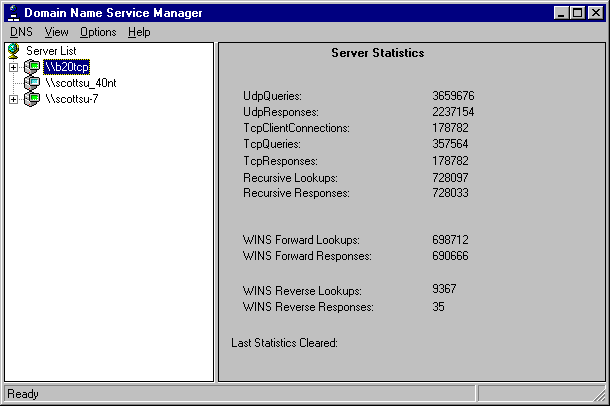
For capacity planning purposes, on a dedicated DNS server, it is important to log the statistics periodically and watch the growth of the queries vs. the memory, disk, network, and CPU performance of the server. Since the statistics are kept since the DNS service was restarted, you will probably want to note the date and time the DNS service was started (you can get this information from the Eventlog).
Now that you know how many queries per second the DNS server is answering, how many is too many? The answer depends on:
If you feel that your DNS server is not responding as fast as it should, then you should first look at the following performance monitor counters on that server. If any of these thresholds are being hit, then the system has a performance problem and you will need to do more investigation:
|
Object |
Counter |
Threshold |
Notes |
|
processor |
% processor time |
> 80% |
|
|
memory |
available bytes |
< 1MB |
|
|
physical disk |
% disk time |
> 67% |
only available if you start the counters from the command line with diskperf -y and reboot |
|
network segment |
% network utilization |
> 40% |
only available if Network Monitor Agent is installed |
If memory is an issue then you should check the "process" object, "DNS" instance, "Private Bytes" counter. If this counter is very high then the DNS service is what is causing the memory available bytes counter to be low. If this is the case then you should add more memory, or possibly investigate what records are currently active in the DNS cache and find out the TTL associated with each.
If processor is an issue then you should check the "process" object, "DNS" instance, "%processor time" counter. If this is > 80 % then you might consider running the DNS server on a more powerful server. If this is not high, and processor %processor time is still high, look at all the other processes and determine which process is requiring large amounts of CPU time.
On a DNS server, physical disk %disk time should not be a problem, unless the system has started paging for lack of memory. If this is the case then you need to treat this as a memory issue.
If network utilization is a problem, you need to find out if it is the DNS server that is causing all of the traffic or another server on the same segment. To do this, use the full featured Network Monitor utility that ships with Microsoft Systems Management Server (this allows you to capture all traffic to and from any specific hardware address) or the reduced feature set utility that ships with Windows NT 4.0 (this only allows you to track traffic to and from the local server).
If you have multiple DNS servers, for example a primary and 2 secondaries, then you will probably want to configure some of the clients to point to one DNS secondary and other clients to point to the other DNS secondary.
A zone transfer is nothing more than a file copy. The entire contents of the database get copied from the primary (or master) to the secondary each time the secondary is "notified" by the primary (or master) that there has been a change.
When the secondary’s DNS service starts or the secondary’s "refresh interval" in its SOA record has expired (by default this is set to 3 hours), it will query its primary to determine the serial number in the SOA record. If it is different than that of its local database, it will ask for a zone transfer.
The first frame is the request for the primary’s SOA record.
secondary primary DNS 0x4000:Std Qry for scottsu.com of type SOA on class INET
+ FRAME: Base frame properties
+ ETHERNET: ETYPE = 0x0800 : Protocol = IP: DOD Internet Protocol
+ IP: ID = 0x7701; Proto = UDP; Len: 57
+ UDP: Src Port: DNS, (53); Dst Port: DNS (53); Length = 37 (0x25)
DNS: 0x4000:Std Qry for scottsu.com of type SOA on class INET addr.
DNS: Query Identifier = 16384 (0x4000)
+ DNS: DNS Flags = Query, OpCode—Std Qry, RCode—No error
DNS: Question Entry Count = 1 (0x1)
DNS: Answer Entry Count = 0 (0x0)
DNS: Name Server Count = 0 (0x0)
DNS: Additional Records Count = 0 (0x0)
DNS: Question Section: scottsu.com of type SOA on class INET addr.
DNS: Question Name: scottsu.com
DNS: Question Type = Start of zone of authority
DNS: Question Class = Internet address class
The next frame is the SOA record being returned.
primary secondary DNS 0x4000:Std Qry Resp. for scottsu.com of type SOA on class INET
+ FRAME: Base frame properties
+ ETHERNET: ETYPE = 0x0800 : Protocol = IP: DOD Internet Protocol
+ IP: ID = 0x3617; Proto = UDP; Len: 149
+ UDP: Src Port: DNS, (53); Dst Port: DNS (53); Length = 129 (0x81)
DNS: 0x4000:Std Qry Resp. for scottsu.com of type SOA on class INET addr.
DNS: Query Identifier = 16384 (0x4000)
+ DNS: DNS Flags = Response, OpCode—Std Qry, AA RA Bits Set, RCode—No error
DNS: Question Entry Count = 1 (0x1)
DNS: Answer Entry Count = 1 (0x1)
DNS: Name Server Count = 0 (0x0)
DNS: Additional Records Count = 0 (0x0)
DNS: Question Section: scottsu.com of type SOA on class INET addr.
DNS: Question Name: scottsu.com
DNS: Question Type = Start of zone of authority
DNS: Question Class = Internet address class
DNS: Answer section: scottsu.com of type SOA on class INET addr.
DNS: Resource Name: scottsu.com
DNS: Resource Type = Start of zone of authority
DNS: Resource Class = Internet address class
DNS: Time To Live = 0 (0x0)
DNS: Resource Data Length = 80 (0x50)
DNS: Primary Name Server: scottsu-7.scottsu.com
DNS: Responsible Authorative Mailbox: Administrator.scottsu-7.scottsu.com
DNS: Version number = 19 (0x13)
DNS: Refresh Interval = 3600 (0xE10)
DNS: Retry interval = 600 (0x258)
DNS: Expiration Limit = 86400 (0x15180)
DNS: Minimum TTL = 3600 (0xE10)
The next frame is the request for the zone transfer.
secondary primary DNS 0x0:Std Qry for scottsu.com of type Req. for zn Xfer
+ FRAME: Base frame properties
+ ETHERNET: ETYPE = 0x0800 : Protocol = IP: DOD Internet Protocol
+ IP: ID = 0x7A01; Proto = TCP; Len: 71
+ TCP: .AP..., len: 31, seq: 365696, ack: 35871892, win: 8760, src: 1072 dst: 53
DNS: 0x0:Std Qry for scottsu.com of type Req. for zn Xfer on class INET addr.
DNS: TCP Length = 29 (0x1D)
DNS: Query Identifier = 0 (0x0)
+ DNS: DNS Flags = Query, OpCode—Std Qry, RCode—No error
DNS: Question Entry Count = 1 (0x1)
DNS: Answer Entry Count = 0 (0x0)
DNS: Name Server Count = 0 (0x0)
DNS: Additional Records Count = 0 (0x0)
DNS: Question Section: scottsu.com of type Req. for zn Xfer on class INET addr.
DNS: Question Name: scottsu.com
DNS: Question Type = Request for zone transfer
DNS: Question Class = Internet address class
The next frame contains the database being returned from the master.
primary secondary DNS 0x0:Std Qry Resp. for scottsu.com of type SOA
+ FRAME: Base frame properties
+ ETHERNET: ETYPE = 0x0800 : Protocol = IP: DOD Internet Protocol
+ IP: ID = 0x3817; Proto = TCP; Len: 163
+ TCP: .AP..., len: 123, seq: 35871892, ack: 365727, win: 8729, src: 53 dst: 1072
DNS: 0x0:Std Qry Resp. for scottsu.com of type SOA on class INET addr.
DNS: TCP Length = 121 (0x79)
DNS: Query Identifier = 0 (0x0)
+ DNS: DNS Flags = Response, OpCode—Std Qry, RA Bits Set, RCode—No error
DNS: Question Entry Count = 1 (0x1)
DNS: Answer Entry Count = 1 (0x1)
DNS: Name Server Count = 0 (0x0)
DNS: Additional Records Count = 0 (0x0)
DNS: Question Section: scottsu.com of type Req. for zn Xfer on class INET addr.
DNS: Question Name: scottsu.com
DNS: Question Type = Request for zone transfer
DNS: Question Class = Internet address class
DNS: Answer section: of type SOA on class INET addr.
DNS: Resource Name: scottsu.com
DNS: Resource Type = Start of zone of authority
DNS: Resource Class = Internet address class
DNS: Time To Live = 0 (0x0)
DNS: Resource Data Length = 80 (0x50)
DNS: Primary Name Server: scottsu-7.scottsu.com
DNS: Responsible Authorative Mailbox: Administrator.scottsu-7.scottsu.com
DNS: Version number = 19 (0x13)
DNS: Refresh Interval = 3600 (0xE10)
DNS: Retry interval = 600 (0x258)
DNS: Expiration Limit = 86400 (0x15180)
DNS: Minimum TTL = 3600 (0xE10)
00000000 00 A0 24 63 AB 22 00 80 C7 A9 EC 0F 08 00 45 00 ..$c."........E.
00000010 02 AB 39 17 40 00 80 06 B9 C6 9D 37 66 34 9D 37 ..9.@......7f4.7
00000020 64 CC 00 35 04 30 02 23 5D 0F 00 05 94 9F 50 18 d..5.0.#].....P.
00000030 22 19 58 A8 00 00 00 3D 00 00 80 80 00 01 00 01 ".X....=........
00000040 00 00 00 00 07 73 63 6F 74 74 73 75 03 63 6F 6D .....scottsu.com
00000050 00 00 FC 00 01 C0 0C FF 01 00 01 00 00 0E 10 00 ................
00000060 14 00 00 00 00 05 00 00 00 58 02 00 00 01 00 00 .........X......
00000070 00 9D 37 66 34 00 40 00 00 80 80 00 01 00 01 00 ..7f4.@.........
00000080 00 00 00 07 73 63 6F 74 74 73 75 03 63 6F 6D 00 ....scottsu.com.
00000090 00 FC 00 01 C0 0C 00 02 00 01 00 00 0E 10 00 17 ................
000000A0 09 73 63 6F 74 74 73 75 2D 37 07 73 63 6F 74 74 .scottsu-7.scott
000000B0 73 75 03 63 6F 6D 00 00 43 00 00 80 80 00 01 00 su.com..C.......
000000C0 01 00 00 00 00 07 73 63 6F 74 74 73 75 03 63 6F ......scottsu.co
000000D0 6D 00 00 FC 00 01 C0 0C 00 02 00 01 00 00 0E 10 m...............
000000E0 00 1A 0C 73 63 6F 74 74 73 75 5F 6E 74 34 30 07 ...scottsu_nt40.
000000F0 73 63 6F 74 74 73 75 03 63 6F 6D 00 00 51 00 00 scottsu.com..Q..
00000100 80 80 00 01 00 01 00 00 00 00 07 73 63 6F 74 74 ...........scott
00000110 73 75 03 63 6F 6D 00 00 FC 00 01 07 67 6C 65 6E su.com......glen
00000120 6E 77 6F C0 0C 00 02 00 01 00 00 0E 10 00 20 0A nwo.............
00000130 63 6F 70 70 65 72 68 65 61 64 07 67 6C 65 6E 6E copperhead.glenn
00000140 77 6F 07 73 63 6F 74 74 73 75 03 63 6F 6D 00 00 wo.scottsu.com..
00000150 40 00 00 80 80 00 01 00 01 00 00 00 00 07 73 63 @.............sc
00000160 6F 74 74 73 75 03 63 6F 6D 00 00 FC 00 01 0A 63 ottsu.com......c
00000170 6F 70 70 65 72 68 65 61 64 07 67 6C 65 6E 6E 77 opperhead.glennw
00000180 6F C0 0C 00 01 00 01 00 00 0E 10 00 04 9D 37 6A o.............7j
00000190 C1 00 36 00 00 80 80 00 01 00 01 00 00 00 00 07 ..6.............
000001A0 73 63 6F 74 74 73 75 03 63 6F 6D 00 00 FC 00 01 scottsu.com.....
000001B0 08 67 6F 6F 6F 6F 6F 6F 64 C0 0C 00 01 00 01 00 .gooooood.......
000001C0 00 00 00 00 04 9D 37 64 64 00 37 00 00 80 80 00 ......7dd.7.....
000001D0 01 00 01 00 00 00 00 07 73 63 6F 74 74 73 75 03 ........scottsu.
000001E0 63 6F 6D 00 00 FC 00 01 09 73 63 6F 74 74 73 75 com......scottsu
000001F0 2D 37 C0 0C 00 01 00 01 00 00 0E 10 00 04 9D 37 -7.............7
00000200 66 34 00 3A 00 00 80 80 00 01 00 01 00 00 00 00 f4.:............
00000210 07 73 63 6F 74 74 73 75 03 63 6F 6D 00 00 FC 00 .scottsu.com....
00000220 01 0C 73 63 6F 74 74 73 75 5F 6E 74 34 30 C0 0C ..scottsu_nt40..
00000230 00 01 00 01 00 00 0E 10 00 04 9D 37 64 CC 00 79 ...........7d..y
00000240 00 00 80 80 00 01 00 01 00 00 00 00 07 73 63 6F .............sco
00000250 74 74 73 75 03 63 6F 6D 00 00 FC 00 01 C0 0C 00 ttsu.com........
00000260 06 00 01 00 00 00 00 00 50 09 73 63 6F 74 74 73 ........P.scotts
00000270 75 2D 37 07 73 63 6F 74 74 73 75 03 63 6F 6D 00 u-7.scottsu.com.
00000280 0D 41 64 6D 69 6E 69 73 74 72 61 74 6F 72 09 73 .Administrator.s
00000290 63 6F 74 74 73 75 2D 37 07 73 63 6F 74 74 73 75 cottsu-7.scottsu
000002A0 03 63 6F 6D 00 00 00 00 13 00 00 0E 10 00 00 02 .com............
000002B0 58 00 01 51 80 00 00 0E 10 X..Q.....
Memory consumed by DNS records
DNS RR records are very small, somewhere in the neighborhood of 16 bytes. Domain records are also very small, they are around 56 bytes. If you load a great deal of records into the server you might not see the DNS process Private Bytes counter jump because the DNS server allocates the memory in blocks.
The way DNS uses the cache is a different story. Virtual (pageable) memory is allocated for cached entries as needed (remember, as a DNS server does a resolution, it caches a copy of the data for that data’s TTL). If the server is starved for memory and more is needed, then this memory will come from the page file (which is usually very slow).
When designing a DNS architecture it is important to ask a number of questions about the current and future infrastructures. Hopefully the following questions will help you develop a reasonable DNS backbone for your corporation.
This is by far the most important question you will have to answer!
There are two different routes to take when designing a DNS architecture for a company’s network. The first option is the easiest—create one DNS domain for the whole company (for example Acme.com). This means that you would have one primary DNS server and one or more secondary DNS servers. There are some downsides to choosing this option. The first being that the Primary DNS may have a problem keeping up with all of the secondaries polling. There are solutions to this problem such as, increase the secondary refresh interval, make some of the secondaries load from other secondaries (that is multiple DNS masters) and/or create some caching servers (allows you to avoid the overhead of a zone transfer—Warning : they are only valuable once they build up their cache). If you choose this approach and you decide in the future that it should be re-designed it can always be broken up.
The second option is more for the larger network installations which span multiple sites (this is the option we will explore in great detail in the rest of the paper). In this design you would have more than one DNS domain. The architecture would consist of one root domain (with a primary DNS server and one or more secondary DNS servers) and with one or more sub-domains (each with a primary DNS server and one or more secondary DNS servers). An example of the subdomains might be Dallas.Acme.Com and Reno.Acme.Com. The reason for such a design is quite obvious. A network architect usually breaks up a corporate DNS domain into multiple DNS domains to distribute the management of parts of the domain to various entities within the organization or to enable multiple zone files since zone files can only be created at the domain level. Another less obvious reason may be to simply allow for organizational affiliation of your systems. If you choose this route then the structure of your domain should mirror the structure of your organization, especially your companies support structure. Either way, you will need to determine how many domains your company will need.
Here is an example of such a configuration showing the DNS servers and the zone database files on each:
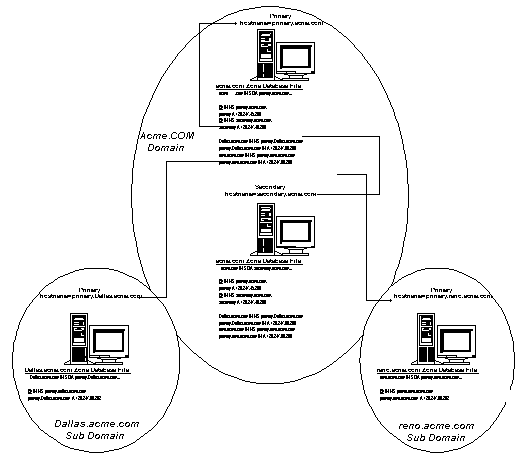
|
From a futures migration standpoint it’s recommended that you create a DNS domain for every Windows NT domain that you currently have in your enterprise. |
It may not be that apparent today, but for a smooth migration to the next major revision of Windows NT this will be important. The next major revision of Windows NT is tightly coupled with the DNS backbone. See the Futures section of this paper for more information.
The following figure tries to show how a name might look in the future, keep in mind that you will still be able to use friendly names such as Scottsu@microsoft.com.
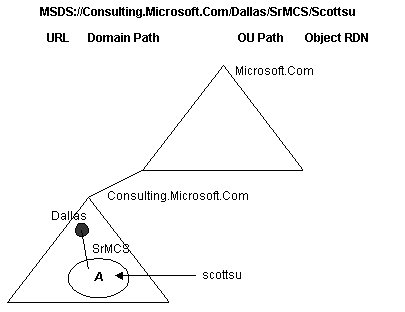
For a general overview of how a Windows NT domain might map to a DNS domain see the following figure. It has a Multiple Master domain with 2 Masters Reno and Dallas, and 6 Resources L100 to L202.
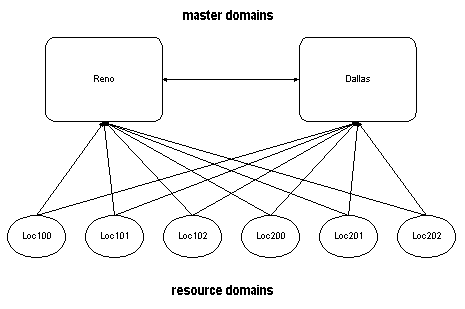
For the previous domain design you might have 9 DNS domains, Acme.com, Reno.Acme.com, Dallas.Acme.com, L100.Reno.com, L101.Reno.com, L102.Reno.com, L201.Dallas.com, L202.Dallas.com and L201.Dallas.com.
Most corporate domains designs fall into one of the following models, the Single domain model, the Master domain model, the Multiple Master domain model or the Complete Trust domain model. For more information on each of these models refer to the Windows NT Adminstration guide.
In this section we are going to discuss two of these models, the Complete Trust model and the Multiple Master model. We will look at the models before DNS and the models after DNS. Hopefully, this will give you an understanding of how to implement DNS within your own environment.
Let’s start with the following domain design (without DNS) and determine the best approach to a DNS design architecture. The following is an example of a Complete Trust domain model. There are 2 domains "Reno" and "Dallas." Let’s assume the following:
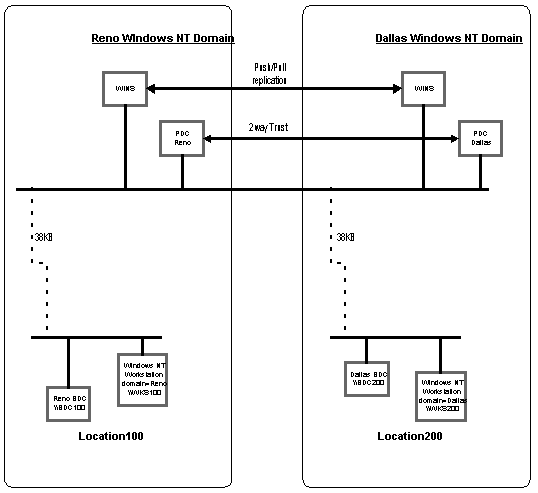
When designing a solution it is important to consider the traffic flow of "session setup" and "logon validation." You never want to design a solution that would keep a client from contacting its local server if the link between the remote location and its data-center was lost.
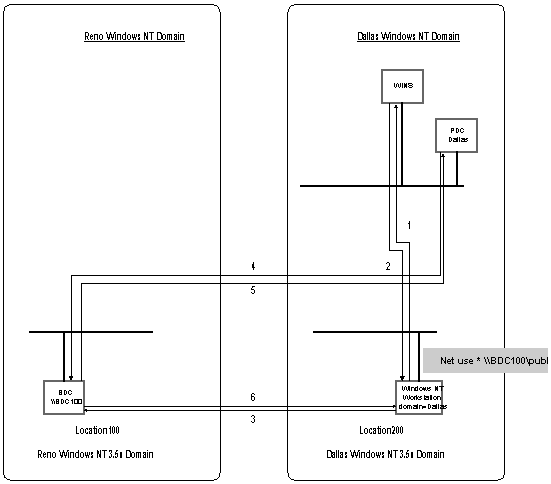
In our example logon validation will occur locally between the clients and the local servers. Session setup and name resolution to the "local" servers will also occur locally because the clients are set up as Mnode TCPIP clients. Session setup and name resolution between a client in one location and a server in another remote location will take a much different path and include both the WINS server in the data-center and the clients domain PDC. In our example (note that in our example some of the devices were removed to make the diagram easier to view), the Windows NT Workstation-based machine in the Dallas domain location 200 is connecting to the server \\BDC100 in the Reno domain location 100. The client first contacts the WINS server in its data-center to get the IP address of the \\BDC100 server (1 and 2). It then tries to establish a session to the \\BDC100 server (3). The \\BDC100 server in turn uses its secure session to the clients PDC for "pass through authentication" purposes (4 and 5). If the security is verified, the client is allowed to establish the session and proceed (6). In this example, there are three physical points of failure, the link between Location 200 and the Dallas data-center, the link between the Dallas data-center and the Reno data-center, and the link between Location 100 and the Reno data-center.
Now that you understand the current architecture, how would you design a Windows NT 4.0 DNS implementation?
Here is a possible solution. There are four zones, four domains (com, acme.com, reno.acme.com and dallas.acme.com) and a DNS server in each remote location in the following design.
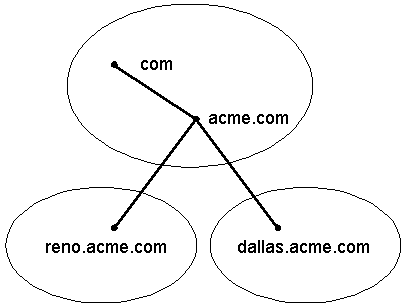
The following are facts about the design:
With this design in place a client from a remote location can now establish a session via HOST name rather than NetBIOS name. For example, instead of typing
Net use * \\BDC100\public
they can type
Net use * \\BDC100.reno.acme.com\public
Let’s follow the path of traffic if the client chooses to connect via the HOST name mechanism,
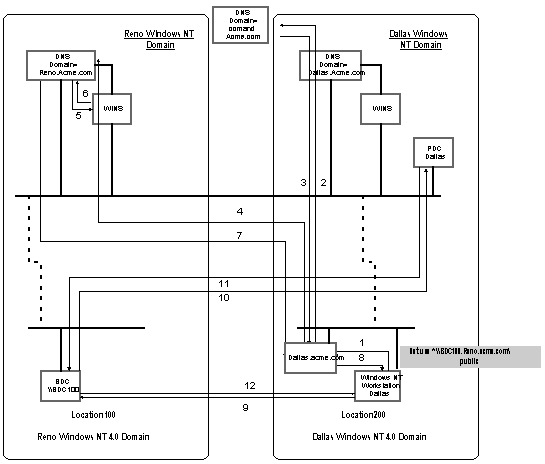
The client contacts its local DNS server with a recursive query (1). The dallas.acme.com cache-only DNS server checks its local memory cache, if the IP address for BDC100.reno.acme.com is not cached, the dallas.acme.com DNS server sends an iterative query to the ROOT server, then to "COM," then to "DOMAIN.COM" (that is Acme.com) (2). The acme.com server will respond back (3) and tell dallas.acme.com to contact reno.acme.com (4). When dallas.acme.com contacts reno.acme.com, the DNS server reno.acme.com will check the WINS server (5) defined in its WINS record (6) and the reno.acme.com responds with the IP address (7) and the directed name query and session setup can continue (8,9,10,11 and 12). If the IP addresses were not cached, it would take eight frames for IP address to name resolution (compared to two frames in the WINS design).
|
If the dallas.acme.com DNS server was configured with a "Forwarder" the request to acme.com would have still been iterative. However, if the dallas.acme.com DNS server was configured as a "Slave" server the request to acme.com would have been recursive. |
Once Dynamic DNS and Enhanced Directory Services become a reality, the WINS servers in this enterprise can be removed and NetBIOS can be turned off. From this point on DNS will be used as the index into the directory to find machine objects such as computers and domain controllers.
In the following section we are going to go through a very simple "well architected" Windows NT 4.0 Multiple Master domain model and show how to implement DNS within that environment for a safe migration to future versions of Windows NT.
Here is the typical Multiple Master layout with two master domains and six resource domains:
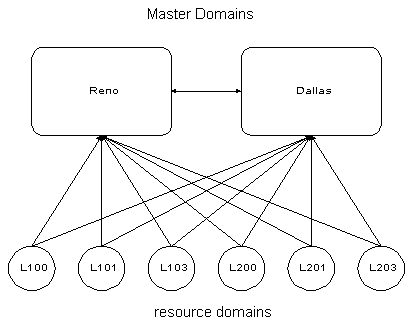
Let’s use the "Reno" and "Dallas" domain structure and assume the following:
The following figure shows the current layout:
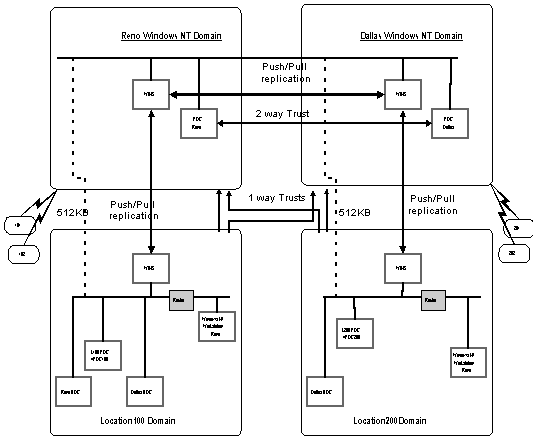
Let’s look at the traffic flow for logon validation and session setup name resolution. In most Multiple Master domain scenarios, the client Windows NT-based machine accounts exist in the resource domain and the user logs onto the Master domain. All logon validation will be done locally within the site. A Windows NT Workstation-based client upon bootup queries the local WINS server for a list of BDCs (via name query for DOMAIN <1C>). The WINS server will respond with a list of up to 25 BDCs (the list contains the PDC and all of the BDCs for the master domain that registered with it, as well as others that were replicated to it). The client then sends a request to each server on the list and uses the first server to respond (which normally will be the local master domain BDC) as its server that it sets up a secure channel with and uses to do logon validation.
Remote session setup from a client running Windows NT client in a resource domain to a server in another resource domain occurs as follows as is shown in the next diagram.
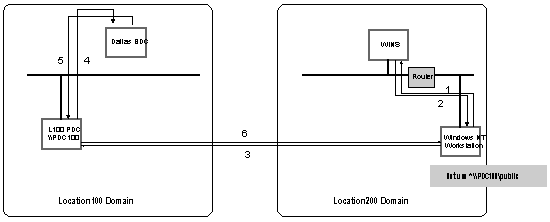
The client running Windows NT Workstation will query the WINS server for the address for the server in the domain it wants to contact (1). The WINS server will reply with the address (2) because it was replicated to it previously. The Windows NT-based workstation will then contact the server directly (3). That server will see that the session setup request is from a user in a trusted master domain and use its secure channel to a trusted domain BDC or PDC to verify the credentials (5) and then the server will either allow the client to connect or reject the request (6).
Now that you understand the current architecture, how would you design a Windows NT 4.0 DNS implementation? The first thing we have to determine is how to structure the DNS domains. We know that for future migration purposes DNS domains should equal Windows NT 4.0 domains. The first and most important question is now answered—that is, how many domains do I need? The answer is, one for each Windows NT domain—ten.
The second question is, how should the domain names map? For example, should we have L100.reno.acme.com or L100.acme.com? In any design it’s important to keep it simple! That means in our case, keep the name as short as possible. There is another part to this second question and that is, what DNS domain should the clients and servers be part of? In the Multiple Master scenario, the logical solution is to put all workstations within a DNS domain called L100.Acme.Com and L200.Acme.Com and so on, then put all servers within a domain called Reno.Acme.Com and Dallas.Acme.Com (this may require changes to each clients TCPIP configuration). This will allow for easy migration to both Dynamic DNS and Enhanced Directory Services.
The third question is, how many servers will we need to support this? There will be 10 DNS domains (the eight expected + acme.com and com) and eight DNS servers, just like there are eight Windows NT domains and domain controllers (PDCs and BDCs). This will require that the DNS server service be running in each of the locations. The service can run on the existing PDC or BDC within the remote location assuming there is adequate capacity. The DNS servers in the locations that house the resource domains will be primaries for their Windows NT resource domain names such as L100. Acme.Com and secondaries to their respective Windows NT Master domains such as Reno.Acme.Com.
With all of this said, the DNS domain hierarchy might look something like the following:
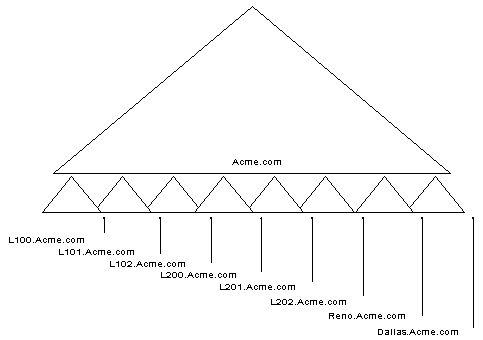
With this design in place, a client from a remote location can now establish a session via HOST name rather than NetBIOS name. For example, instead of typing
Net use * \\WKS100\public
they can type
Net use * \\WKS100.L100.acme.com\public
If the client chooses to connect via the HOST name mechanism, let’s follow the path of traffic and compare it to the path via WINS (note that in our example some of the devices were removed to make the diagram easier to view).
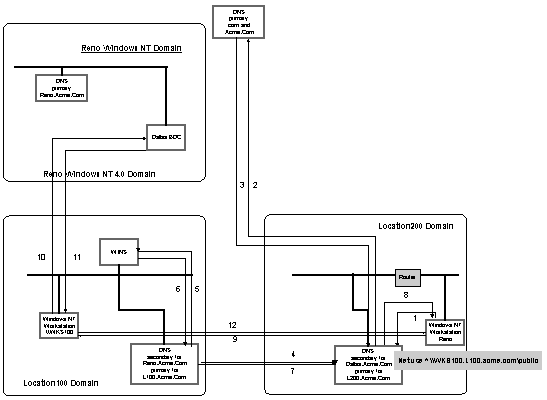
The client contacts its local DNS server with a recursive query (1) for the "NT workstation.domain." The local DNS server checks its local memory cache, and if the IP address for WKS100.L100.acme.com is not cached, the local DNS server sends an iterative query to the ROOT server, then to "COM," then to "DOMAIN.COM" (that is acme.com) (2). The acme.com server will respond (3) back and tell the local DNS server to contact L100.acme.com (4). L100.acme.com will check the WINS server (5 and 6) (the DNS server asks itself, "I should have the IP address for host WKS100.L100.acme.com because I am authoritative for domain L100.acme.com, but I don’t, so check WINS") defined in its WINS record and responds with the IP address (8) and the directed name query and session setup can continue (9,10,11,12). If the IP addresses were not cached, it would take eight frames for IP address to name resolution (compared to two frames in the WINS design).
|
Both zones on the DNS server within the remote location should point to the same local WINS server. |
|
The local DNS server authoritative for reno.acme.com did not contact its local WINS server because the DNS name being asked for was not a direct child of its DNS domain reno.acme.com. It was only a direct child of a DNS server that was authoritative for L100.acme.com. |
A client from a remote location can also establish a session with a remote server via the HOST name rather than NetBIOS name. For example, instead of typing
Net use * \\PDC100\public
they can type
Net use * \\PDC100.reno.acme.com\public
If the client chooses to connect via the HOST name mechanism, let’s follow the path of traffic and compare it to the path via WINS (note that in our example some of the devices were removed to make the diagram easier to view).
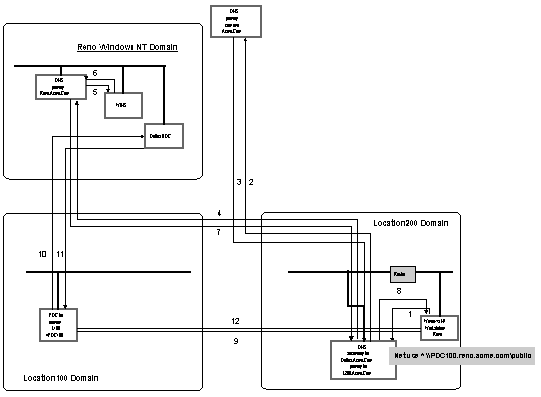
The client contacts its local DNS server with a recursive query (1) for the "NT workstation.domain." The local DNS server checks its local memory cache, and if the IP address for PDC100.reno.acme.com is not cached, the local DNS server sends an iterative query to the ROOT server, then to "COM," then to "DOMAIN.COM" (that is acme.com) (2). The acme.com server will respond (3) back and tell the local DNS server to contact reno.acme.com (4). When the local DNS server contacts reno.acme.com, the DNS reno.acme.com will check the WINS server (5 and 6) (the DNS server asks itself, "I should have the IP address for host PDC100.reno.acme.com because I am authoritative for domain Reno.acme.com, but I don’t, so check WINS") defined in its WINS record and respond with the IP address (7). The local DNS then returns that address to the client (8) and the directed name query and session setup can continue (9,10,11,12). If the IP addresses were not cached it would take eight frames for IP address to name resolution (compared to two frames in the WINS design).
|
The local DNS server did not contact its local WINS server because the DNS name being asked for was not a direct child of a DNS domain L200.acme.com or dallas.acme.com it was only a direct child of a DNS server that was authoritative for reno.acme.com. |
Once Dynamic DNS and Enhanced Directory Services become a reality the WINS servers in this enterprise can be removed and NetBIOS can be turned off. From this point on, DNS will be used as the index into the directory to find machine objects such as computers and domain controllers.
It may seem like there are more points of failure for name resolution (eight frames via DNS versus. two frames via WINS), however with this architecture there will be less Dynamic DNS replication than there is WINS replication today and the flat 16 character NetBIOS name space will be history!
Dynamic DNS , IPv6, Incremental Transfer, Secure DNS, Limited use (or no use, it’s your choice) of NetBIOS.
The next generation of Windows NT will contain an Enhanced Directory Services implementation. There will be a new way to think about domains, users, groups, and trusts. Enhanced DS domains will map directly to DNS domains, and administration for users and groups can be delegated to Organizational Units (OU) in the directory. The new Enhanced DS domains will be much more functional than Windows NT Server domains today.
The key thing to understand from a DNS implementation perspective, is that DNS will become the primary locator service in the Enhanced Directory Services network. The Enhanced DS clients will use DNS, similar to the way that clients running Windows NT 4.0 use WINS today, to find other servers running the DS service and other hosts on the network.
This section takes a look at some of the new Enhanced Directory Services concepts as well as some of the new standards that will effect DNS in the future. It then goes into what a good DNS/DS design might look like in the future and hopefully will give you an indication of how you might design your network today to be prepared for this future migration.
Windows NT 4.0 includes two name-to-IP-address mapping services—WINS and DNS. One key difference between the two is that whereas WINS accommodates dynamic registration of NetBIOS names (and associated IP addresses), DNS names (and associated IP addresses) must be statically entered into the DNS service database.
Static registration of name-to-IP-address information is undesirable in the Windows NT/Windows 95 operating systems. This is because in all but very small Microsoft network installations, machines do not have static IP address assignments. The machines use the Dynamic Host Configuration Protocol (DHCP) to obtain an IP address assignment each time they initialize ("boot up").
A proposal for dynamic registration of DNS information is under consideration by the IETF (Internet Engineering Task Force). You can download the specification from "http://ds.internic.net/internet-drafts/draft-ietf-dnsind-dynDNS-09.txt". With DNS "dynamic update," a client machine, having obtained its assigned IP address from DHCP, can use a standard protocol to dynamically register its DNS name and IP address in the DNS database. In the Windows NT 4.0 time-frame, it was determined that "dynamic update" should not be implemented due to the fluid status of the specification, and scalability concerns. The current dynamic DNS proposal is based on a "pull from single master" replication model and consequently, if the single master is down or unreachable, dynamic updates cannot occur. Microsoft favors a multiple master arrangement similar to WINS that would allow registrations to continue without a single point of failure.
In the long run, using DNS dynamic update is more desirable than the
Windows NT 4.0 DNS-WINS integration for the following reasons:
|
Microsoft-based clients can not register with any of the current versions of Dynamic DNS, and dynamic DNS servers can not replicate their dynamic data to other NON-Dynamic DNS servers. |
|
|
|
In current implementations of Dynamic DNS, the primary is a single point of failure. All of the clients must register their names and IP addresses with this machine. If this machine is down then no updates to the DNS database can occur. |
IPv6 is defined in RFC 1883 (http://ds2.internic.net/rfc/rfc1883.txt). Sometimes this protocol is referred to as "IP Next Generation or IPng." IP version 6 (IPv6) is a new version of the Internet Protocol designed as a successor to IP version 4 (IPv4) [RFC-791]. The changes from IPv4 to IPv6 fall into the following categories:
With the onset of this new standard, changes will need to be made to the DNS protocol. RFC 1886 (http://ds2.internic.net/rfc/rfc1886.txt) defines these changes. The changes include a new resource record type to store an IPv6 address, a new domain to support lookups based on an IPv6 address, and updated definitions of existing query types that return Internet addresses as part of additional section processing. The extensions are designed to be compatible with existing applications and, in particular, DNS implementations themselves.
Current support for the storage of Internet addresses in the Domain Name System (DNS) cannot easily be extended to support IPv6 addresses since applications assume that address queries return 32-bit IPv4 addresses.
Incremental Transfers—Multimaster replication
Incremental Transfer is for rapid propagation of changes to a DNS database. Windows NT 4.0 does not support the Incremental Transfer protocol, however it will be supported in the future. The Incremental Transfer protocol is designed to reduce latency and decrease the amount of data send during a zone transfer. It does this through two mechanisms.
Notification is used to actively notifying servers of a change to a zone file. The notification is accomplished by the NOTIFY extension of DNS (Microsoft DNS support Notify in Windows NT 4.0). For more information on the notify specification refer to the Internet draft on http://ds.internic.net/internet-drafts/draft-ietf-dnsind-notify-07.txt.
Zone propagation is improved by sending just the information which has changed. This is a much better method than the current full zone transfer mechanism, since the current method always transfers the entire zone file. For more information on the Incremental Transfer protocol see the Internet draft on http://ds.internic.net/internet-drafts/draft-ietf-dnsind-ixfr-06.txt.
The replication of dynamic data will work very similar to the way that WINS works today, however the data stays within the zone instead of replicating unnecessary data to each and every server (like WINS). The following figure displays the resolver registration and how replication will work:
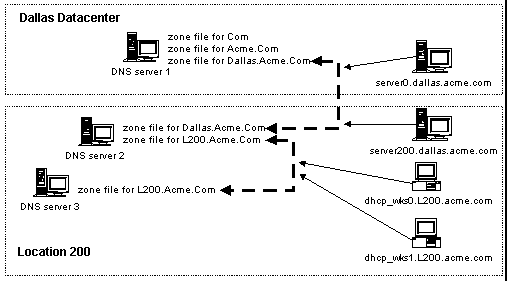
The dynamic database for L200.acme.com only replicates between DNS server 2 and DNS server 3. The dynamic database for Dallas.acme.com only replicates between DNS server 1 and DNS server 2.
As DNS becomes a critical operational part of the Internet infrastructure, a defined method of security will need to be put in place to assure data integrity and authentication. Extensions to the DNS are described in the IETF-DRAFT "DNS Protocol Security Extensions--30 January 1996" that provide these services to security-aware resolvers or applications through the use of cryptographic digital signatures. These digital signatures are included in secured zones as resource records. Security can still be provided even through non-security-aware DNS servers in many cases.
The extensions also provide for the storage of authenticated public keys in the DNS. This storage of keys can support general public key distribution service as well as DNS security. The stored keys enable security-aware resolvers to learn the authenticating key of zones in addition to those for which they are initially configured. Keys associated with DNS names can be retrieved to support other protocols. Provision is made for a variety of key types and algorithms. In addition, the security extensions provide for the optional authentication of DNS protocol transactions. For more information see "http://ds.internic.net/internet-drafts/draft-ietf-dnssec-secext-09.txt".
|
|
In current implementations of Dynamic DNS, the vendors had to "roll their own" security protocol because of the lack of a defined standard. Be careful if you implement one of these products as it may become incompatible with future products when a specification is defined. |
Let’s take a look at the migration process to Enhanced Directory Services. The new Enhanced DS domains will be fully interoperable with Windows NT Server domains. (that is Existing Windows NT Server domains will be able to trust Enhanced DS domains, just as they trust other Windows NT Server domains today.) Enhanced DS servers will also be able to function as backup domain controllers for Windows NT Server domains. This interoperability will allow the upgrade to Enhanced DS server to occur in an orderly fashion, while allowing existing Windows NT Server-based servers to work without modification.
Administrators will not be forced to use the Enhanced DS administration model until they’re ready to do so. Even when Enhanced DS servers are on the network, for example, administrators will be able to maintain all account information in the Windows NT Server domain, using the current Windows NT Server administration tools. Thus, administrators will be able to deploy Enhanced DS servers without disrupting the administration of the network.
As Enhanced DS servers are deployed, administrators can begin to store user account information on Enhanced DS servers, while continuing to store and administer those accounts in and from the Windows NT Server domain. This will allow organizations to migrate account information to a Enhanced DS server in an incremental fashion as they gain confidence in the stability and capability of Enhanced DS. Once Enhanced DS servers are well-established, administrators will be able to maintain all account information on Enhanced DS servers, using the Enhanced DS tools. Further, for non-Enhanced DS clients, however, Enhanced DS servers will continue to look and act just like
Windows NT Server 4.x-based servers.
Once all client and server transitions have been completed, the Enhanced DS environment will be the everyday environment for both end users and system administrators. And, the transition enabled by the interoperability between and integration of Windows NT Server and Enhanced DS will allow organizations to make an easy transition to the unified and global name space provided by Enhanced DS, without disrupting the day-to-day operations of the network.
There will continue to be support for NetBEUI and IPX, however it is important to understand that the Microsoft stated direction is TCP/IP, as is true for most other networking vendors.
If you choose to use IPX and NetEUI in the next revision of Windows NT, you will be required to use NetBIOS. However, if you choose TCP/IP as your choice protocol, NetBIOS is not required as part of the architecture.
You will have a need to use NetBIOS name resolution on your network, as long as you have applications that require NetBIOS names. When you choose to begin the migration to the Enhanced DS you need to find out all of the applications (services and so forth) that require NetBIOS and have a host name migration plan for each.
Finding DCs in an Enhanced Directory Services environment
On the path to a true Windows NT Enhanced Directory Services environment (without NetBIOS) there will be a required migration path that includes the use of all three standards to support backward compatibility with legacy NetBIOS systems.
As machines running Windows NT Enhanced Directory Services start up, they will use existing WINS protocol to register NetBIOS names with their configured WINS server, and register their "A" record(s) with their DNS server. Hence, the Windows NT NetBIOS and DNS name-to-IP-address mappings are made available to all machines using Windows NT Enhanced DS and down level machines (Windows 95, Windows for Workgroups, and so on).
As servers running Windows NT Enhanced DS, that contain the Directory Services Database, start up they will not only register a NetBIOS name with the WINS server, and an "A" record with the DNS server, but they will also register another record with the DNS server that defines the location, DS access protocols supported, transport protocols and so forth. There may be multiple "A" records registered for a machine. For example, an Enhanced Directory Services DC may register:
phoenix.nt.microsoft.com A 123.123.123.123
domain-controllers.nt.microsoft.com A 123.123.123.123
This will allow other Enhanced Directory Services workstations to find DCs to validate their security credentials.
Things You Can Count on for the Future
Rules to Architect a Good DNS Solution for the Future
Every site DNS server should be a primary for the site specific DNS domain and a secondary for the parent DNS domain.
Windows-based clients should be registered in a site specific DNS domain.
Servers running Windows NT Server should be registered in a master DNS domain.
For the latest information on Windows NT Server, check out our World Wide Web site at http://www.microsoft.com/backoffice or the Windows NT Server Forum on the Microsoft Network (GO WORD: MSNTS). To access information via the World Wide Web, go to http://www.microsoft.com and select Microsoft BackOffice.
Asking the DNS for an IP address of a HOST
The example consists of the following setup with four hosts, two of which are Primary DNS servers.
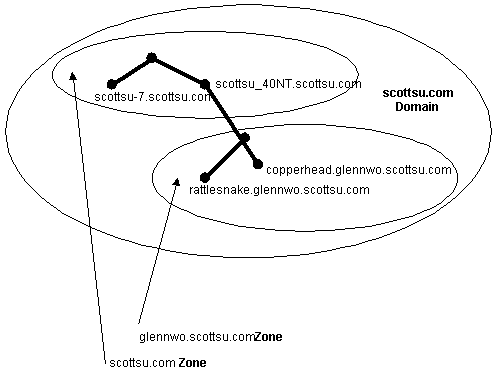
The Windows NT 4.0-based client does the following PING. The arrows represent a packet and the numbers associate the frame number with the trace below.
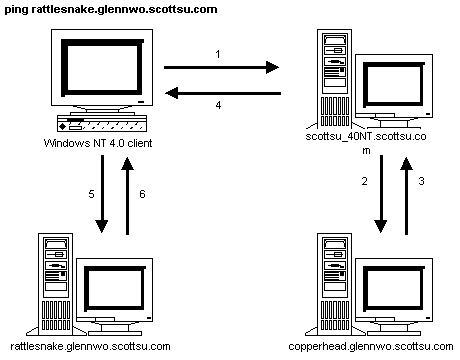
The trace is of the following query:
Ping rattlesnake.glennwo.scottsu.com
That is the Host is rattlesnake and the domain is glennwo.scottsu.com
The client first has to query its DNS server for the names.
Note that the query is recursive.
1 SCOTTSU-7 SCOTTSU_NT40 DNS 0x1:Std Qry for rattlesnake.glennwo.scottsu.com
IP: ID = 0x9608; Proto = UDP; Len: 77
IP: Version = 4 (0x4)
IP: Header Length = 20 (0x14)
IP: Service Type = 0 (0x0)
IP: Total Length = 77 (0x4D)
IP: Identification = 38408 (0x9608)
IP: Flags Summary = 0 (0x0)
IP: Fragment Offset = 0 (0x0) bytes
IP: Time to Live = 128 (0x80)
IP: Protocol = UDP—User Datagram
IP: CheckSum = 0x9F28
IP: Source Address = 157.55.102.52
IP: Destination Address = 157.55.100.204
IP: Data: Number of data bytes remaining = 57 (0x0039)
UDP: Src Port: Unknown, (1066); Dst Port: DNS (53); Length = 57 (0x39)
UDP: Source Port = 0x042A
UDP: Destination Port = DNS
UDP: Total length = 57 (0x39) bytes
UDP: CheckSum = 0xB2D7
UDP: Data: Number of data bytes remaining = 49 (0x0031)
DNS: 0x1:Std Qry for rattlesnake.glennwo.scottsu.com of type Host Addr on class INET addr.
DNS: Query Identifier = 1 (0x1)
DNS: DNS Flags = Query, OpCode—Std Qry, RD Bits Set, RCode—No error
DNS: 0............... = Query
DNS: .0000........... = Standard Query
DNS: .....0.......... = Server not authority for domain
DNS: ......0......... = Message complete
DNS: .......1........ = Recursive query desired
DNS: ........0....... = Recursive queries supported by server
DNS: .........000.... = Reserved
DNS: ............0000 = No error
DNS: Question Entry Count = 1 (0x1)
DNS: Answer Entry Count = 0 (0x0)
DNS: Name Server Count = 0 (0x0)
DNS: Additional Records Count = 0 (0x0)
DNS: Question Section: rattlesnake.glennwo.scottsu.com of type Host Addr on class INET addr.
DNS: Question Name: rattlesnake.glennwo.scottsu.com
DNS: Question Type = Host Address
DNS: Question Class = Internet address class
The scottsu_40NT.scottsu.com is not authoritative for the domain glennwo.scottsu.com, so the scottsu_40NT.scottsu.com Host forwards the request to the subdomain DNS server copperhead.glennwo.scottsu.com.
Note that the query is iterative.
2 SCOTTSU_NT40 COPPERHEAD DNS 0x5:Std Qry for rattlesnake.glennwo.scottsu.com
IP: ID = 0x9C1C; Proto = UDP; Len: 77
IP: Version = 4 (0x4)
IP: Header Length = 20 (0x14)
IP: Service Type = 0 (0x0)
IP: Total Length = 77 (0x4D)
IP: Identification = 39964 (0x9C1C)
IP: Flags Summary = 0 (0x0)
IP: Fragment Offset = 0 (0x0) bytes
IP: Time to Live = 128 (0x80)
IP: Protocol = UDP—User Datagram
IP: CheckSum = 0x9487
IP: Source Address = 157.55.100.204
IP: Destination Address = 157.55.106.193
IP: Data: Number of data bytes remaining = 57 (0x0039)
UDP: Src Port: DNS, (53); Dst Port: DNS (53); Length = 57 (0x39)
UDP: Source Port = DNS
UDP: Destination Port = DNS
UDP: Total length = 57 (0x39) bytes
UDP: CheckSum = 0xB33B
UDP: Data: Number of data bytes remaining = 49 (0x0031)
DNS: 0x5:Std Qry for rattlesnake.glennwo.scottsu.com of type Host Addr on class INET addr.
DNS: Query Identifier = 5 (0x5)
DNS: DNS Flags = Query, OpCode—Std Qry, RCode—No error
DNS: 0............... = Query
DNS: .0000........... = Standard Query
DNS: .....0.......... = Server not authority for domain
DNS: ......0......... = Message complete
DNS: .......0........ = Iterative query desired
DNS: ........0....... = Recursive queries supported by server
DNS: .........000.... = Reserved
DNS: ............0000 = No error
DNS: Question Entry Count = 1 (0x1)
DNS: Answer Entry Count = 0 (0x0)
DNS: Name Server Count = 0 (0x0)
DNS: Additional Records Count = 0 (0x0)
DNS: Question Section: rattlesnake.glennwo.scottsu.com of type Host Addr on class INET addr.
DNS: Question Name: rattlesnake.glennwo.scottsu.com
DNS: Question Type = Host Address
DNS: Question Class = Internet address class
The Copperhead.glennwo.scottsu.com Host replies back to the Scottsu_40NT DNS server with the data.
3 COPPERHEAD SCOTTSU_NT40 DNS 0x5:Std Qry Resp. for rattlesnake.glennwo.scottsu.com
IP: ID = 0x5F04; Proto = UDP; Len: 93
IP: Version = 4 (0x4)
IP: Header Length = 20 (0x14)
IP: Service Type = 0 (0x0)
IP: Total Length = 93 (0x5D)
IP: Identification = 24324 (0x5F04)
IP: Flags Summary = 0 (0x0)
IP: Fragment Offset = 0 (0x0) bytes
IP: Time to Live = 128 (0x80)
IP: Protocol = UDP—User Datagram
IP: CheckSum = 0xD18F
IP: Source Address = 157.55.106.193
IP: Destination Address = 157.55.100.204
IP: Data: Number of data bytes remaining = 73 (0x0049)
UDP: Src Port: DNS, (53); Dst Port: DNS (53); Length = 73 (0x49)
UDP: Source Port = DNS
UDP: Destination Port = DNS
UDP: Total length = 73 (0x49) bytes
UDP: CheckSum = 0x8BD1
UDP: Data: Number of data bytes remaining = 65 (0x0041)
DNS: 0x5:Std Qry Resp. for rattlesnake.glennwo.scottsu.com of type Host Addr on class INET addr.
DNS: Query Identifier = 5 (0x5)
DNS: DNS Flags = Response, OpCode—Std Qry, AA RA Bits Set, RCode—No error
DNS: 1............... = Response
DNS: .0000........... = Standard Query
DNS: .....1.......... = Server authority for domain
DNS: ......0......... = Message complete
DNS: .......0........ = Iterative query desired
DNS: ........1....... = No recursive queries
DNS: .........000.... = Reserved
DNS: ............0000 = No error
DNS: Question Entry Count = 1 (0x1)
DNS: Answer Entry Count = 1 (0x1)
DNS: Name Server Count = 0 (0x0)
DNS: Additional Records Count = 0 (0x0)
DNS: Question Section: rattlesnake.glennwo.scottsu.com of type Host Addr on class INET addr.
DNS: Question Name: rattlesnake.glennwo.scottsu.com
DNS: Question Type = Host Address
DNS: Question Class = Internet address class
DNS: Answer section: rattlesnake.glennwo.scottsu.com of type Host Addr on class INET addr.
DNS: Resource Name: rattlesnake.glennwo.scottsu.com
DNS: Resource Type = Host Address
DNS: Resource Class = Internet address class
DNS: Time To Live = 0 (0x0)
DNS: Resource Data Length = 4 (0x4)
DNS: IP address = 157.55.107.88
The data is returned back to the client.
4 SCOTTSU_NT40 SCOTTSU-7 DNS 0x1:Std Qry Resp. for rattlesnake.glennwo.scottsu.com
IP: ID = 0x9D1C; Proto = UDP; Len: 93
IP: Version = 4 (0x4)
IP: Header Length = 20 (0x14)
IP: Service Type = 0 (0x0)
IP: Total Length = 93 (0x5D)
IP: Identification = 40220 (0x9D1C)
IP: Flags Summary = 0 (0x0)
IP: Fragment Offset = 0 (0x0) bytes
IP: Time to Live = 128 (0x80)
IP: Protocol = UDP—User Datagram
IP: CheckSum = 0x9804
IP: Source Address = 157.55.100.204
IP: Destination Address = 157.55.102.52
IP: Data: Number of data bytes remaining = 73 (0x0049)
UDP: Src Port: DNS, (53); Dst Port: Unknown (1066); Length = 73 (0x49)
UDP: Source Port = DNS
UDP: Destination Port = 0x042A
UDP: Total length = 73 (0x49) bytes
UDP: CheckSum = 0x8F6D
UDP: Data: Number of data bytes remaining = 65 (0x0041)
DNS: 0x1:Std Qry Resp. for rattlesnake.glennwo.scottsu.com of type Host Addr on class INET addr.
DNS: Query Identifier = 1 (0x1)
DNS: DNS Flags = Response, OpCode—Std Qry, RD RA Bits Set, RCode—No error
DNS: 1............... = Response
DNS: .0000........... = Standard Query
DNS: .....0.......... = Server not authority for domain
DNS: ......0......... = Message complete
DNS: .......1........ = Recursive query desired
DNS: ........1....... = No recursive queries
DNS: .........000.... = Reserved
DNS: ............0000 = No error
DNS: Question Entry Count = 1 (0x1)
DNS: Answer Entry Count = 1 (0x1)
DNS: Name Server Count = 0 (0x0)
DNS: Additional Records Count = 0 (0x0)
DNS: Question Section: rattlesnake.glennwo.scottsu.com of type Host Addr on class INET addr.
DNS: Question Name: rattlesnake.glennwo.scottsu.com
DNS: Question Type = Host Address
DNS: Question Class = Internet address class
DNS: Answer section: rattlesnake.glennwo.scottsu.com of type Host Addr on class INET addr.
DNS: Resource Name: rattlesnake.glennwo.scottsu.com
DNS: Resource Type = Host Address
DNS: Resource Class = Internet address class
DNS: Time To Live = 0 (0x0)
DNS: Resource Data Length = 4 (0x4)
DNS: IP address = 157.55.107.88
The client can then PING the server.
5 SCOTTSU-7 RATTLESNAKE ICMP Echo, From 157.55.102.52 To 157.55.107.88
6 RATTLESNAKE SCOTTSU-7 ICMP Echo Reply, To 157.55.102.52 From 157.55.107.88
The following is a trace of the new behavior of Windows NT 4.0 that allows a client to connect up to a Windows NT-based server via the HOST name rather than the NetBIOS computer name. This is a trace of the following command:
Net Use * \\scottsuPDC.scottsu.com\c$
Query the DNS for the Host name scottsuPDC.scotts.com
1 4.248 SCOTTSU-7 SCOTTSU_NT40 DNS 0x6:Std Qry for SCOTTSUPDC.SCOTTSU.COM
IP: Source Address = 157.55.102.52
IP: Destination Address = 157.55.100.204
UDP: Src Port: Unknown, (1057); Dst Port: DNS (53); Length = 48 (0x30)
UDP: Source Port = 0x0421
UDP: Destination Port = DNS
UDP: Total length = 48 (0x30) bytes
UDP: CheckSum = 0x8FEA
UDP: Data: Number of data bytes remaining = 40 (0x0028)
DNS: 0x6:Std Qry for SCOTTSUPDC.SCOTTSU.COM of type Host Addr on class INET addr.
DNS: Query Identifier = 6 (0x6)
DNS: DNS Flags = Query, OpCode—Std Qry, RD Bits Set, RCode—No error
DNS: 0............... = Query
DNS: .0000........... = Standard Query
DNS: .....0.......... = Server not authority for domain
DNS: ......0......... = Message complete
DNS: .......1........ = Recursive query desired
DNS: ........0....... = Recursive queries supported by server
DNS: .........000.... = Reserved
DNS: ............0000 = No error
DNS: Question Entry Count = 1 (0x1)
DNS: Answer Entry Count = 0 (0x0)
DNS: Name Server Count = 0 (0x0)
DNS: Additional Records Count = 0 (0x0)
DNS: Question Section: SCOTTSUPDC.SCOTTSU.COM of type Host Addr on class INET addr.
DNS: Question Name: SCOTTSUPDC.SCOTTSU.COM
DNS: Question Type = Host Address
DNS: Question Class = Internet address class
This is the response from the DNS server. The IP address for scottsuPDC.scottsu.com is at the end of the frame
2 4.255 SCOTTSU_NT40 SCOTTSU-7 DNS 0x6:Std Qry Resp. for SCOTTSUPDC.SCOTTSU.COM
IP: Source Address = 157.55.100.204
IP: Destination Address = 157.55.102.52
UDP: Src Port: DNS, (53); Dst Port: Unknown (1057); Length = 64 (0x40)
UDP: Source Port = DNS
UDP: Destination Port = 0x0421
UDP: Total length = 64 (0x40) bytes
UDP: CheckSum = 0x4932
UDP: Data: Number of data bytes remaining = 56 (0x0038)
DNS: 0x6:Std Qry Resp. for SCOTTSUPDC.SCOTTSU.COM of type Host Addr on class INET addr.
DNS: Query Identifier = 6 (0x6)
DNS: DNS Flags = Response, OpCode—Std Qry, AA RD RA Bits Set, RCode—No error
DNS: 1............... = Response
DNS: .0000........... = Standard Query
DNS: .....1.......... = Server authority for domain
DNS: ......0......... = Message complete
DNS: .......1........ = Recursive query desired
DNS: ........1....... = No recursive queries
DNS: .........000.... = Reserved
DNS: ............0000 = No error
DNS: Question Entry Count = 1 (0x1)
DNS: Answer Entry Count = 1 (0x1)
DNS: Name Server Count = 0 (0x0)
DNS: Additional Records Count = 0 (0x0)
DNS: Question Section: SCOTTSUPDC.SCOTTSU.COM of type Host Addr on class INET addr.
DNS: Question Name: SCOTTSUPDC.SCOTTSU.COM
DNS: Question Type = Host Address
DNS: Question Class = Internet address class
DNS: Answer section: SCOTTSUPDC.SCOTTSU.COM of type Host Addr on class INET addr.
DNS: Resource Name: SCOTTSUPDC.SCOTTSU.COM
DNS: Resource Type = Host Address
DNS: Resource Class = Internet address class
DNS: Time To Live = 0 (0x0)
DNS: Resource Data Length = 4 (0x4)
DNS: IP address = 157.55.100.204
Then the client does an Adapter Status on the IP address to find what names that machine has registered
3 4.254 SCOTTSU-7 SCOTTSU_NT40 NBT NS: Query req. for *<00...(15)>
IP: Source Address = 157.55.102.52
IP: Destination Address = 157.55.100.204
UDP: Src Port: NETBIOS Name Service, (137); Dst Port: NETBIOS Name Service (137); Length = 58 (0x3A)
UDP: Source Port = NETBIOS Name Service
UDP: Destination Port = NETBIOS Name Service
UDP: Total length = 58 (0x3A) bytes
UDP: CheckSum = 0x3A63
UDP: Data: Number of data bytes remaining = 50 (0x0032)
NBT: NS: Query req. for *<00...(15)>
NBT: Transaction ID = 32860 (0x805C)
NBT: Flags Summary = 0x0000—Req.; Query; Success
NBT: 0............... = Request
NBT: .0000........... = Query
NBT: .....0.......... = Non-authoritative Answer
NBT: ......0......... = Datagram not truncated
NBT: .......0........ = Recursion not desired
NBT: ........0....... = Recursion not available
NBT: .........0...... = Reserved
NBT: ..........0..... = Reserved
NBT: ...........0.... = Not a broadcast packet
NBT: ............0000 = Success
NBT: Question Count = 1 (0x1)
NBT: Answer Count = 0 (0x0)
NBT: Name Service Count = 0 (0x0)
NBT: Additional Record Count = 0 (0x0)
NBT: Question Name = *<00...(15)>
NBT: Question Type = Node Status Request
NBT: Question Class = Internet Class
This is the response to the Adapter Status. The machine has a number of NetBIOS names registered.
4 4.255 SCOTTSU_NT40 SCOTTSU-7 NBT NS: Query (Node Status) resp. for *<00...(15)>, Success
IP: Source Address = 157.55.100.204
IP: Destination Address = 157.55.102.52
UDP: Src Port: NETBIOS Name Service, (137); Dst Port: NETBIOS Name Service (137); Length = 345 (0x159)
UDP: Source Port = NETBIOS Name Service
UDP: Destination Port = NETBIOS Name Service
UDP: Total length = 345 (0x159) bytes
UDP: CheckSum = 0xC551
UDP: Data: Number of data bytes remaining = 337 (0x0151)
NBT: NS: Query (Node Status) resp. for *<00...(15)>, Success
NBT: Transaction ID = 32860 (0x805C)
NBT: Flags Summary = 0x8400—Resp.; Query; Success
NBT: 1............... = Response
NBT: .0000........... = Query
NBT: .....1.......... = Authoritative Answer
NBT: ......0......... = Datagram not truncated
NBT: .......0........ = Recursion not desired
NBT: ........0....... = Recursion not available
NBT: .........0...... = Reserved
NBT: ..........0..... = Reserved
NBT: ...........0.... = Not a broadcast packet
NBT: ............0000 = Success
NBT: Question Count = 0 (0x0)
NBT: Answer Count = 1 (0x1)
NBT: Name Service Count = 0 (0x0)
NBT: Additional Record Count = 0 (0x0)
NBT: Resource Record Name = *<00...(15)>
NBT: Resource Record Type = Node Status Request
NBT: Resource Record Class = Internet Class
NBT: Time To Live = 0 (0x0)
NBT: RDATA Length = 263 (0x107)
NBT: Number of Names = 12 (0xC)
NBT: ASCII Name = SCOTTSU_NT40
NBT: Resource Record Flags = 17408 (0x4400)
NBT: ......0......... = Non-Permanent
NBT: .....1.......... = Active Name
NBT: ....0........... = Name is not in Conflict
NBT: ...0............ = Not Deregistering
NBT: .10............. = M Node
NBT: 0............... = Unique NetBIOS Name
NBT: ASCII Name = SCOTTSU_NT40 00
NBT: Resource Record Flags = 17408 (0x4400)
NBT: ......0......... = Non-Permanent
NBT: .....1.......... = Active Name
NBT: ....0........... = Name is not in Conflict
NBT: ...0............ = Not Deregistering
NBT: .10............. = M Node
NBT: 0............... = Unique NetBIOS Name
NBT: ASCII Name = SCOTTSU_NT40D 00
NBT: Resource Record Flags = 50176 (0xC400)
NBT: ......0......... = Non-Permanent
NBT: .....1.......... = Active Name
NBT: ....0........... = Name is not in Conflict
NBT: ...0............ = Not Deregistering
NBT: .10............. = M Node
NBT: 1............... = Group NetBIOS Name
NBT: ASCII Name = SCOTTSU_NT40D <1C>
NBT: Resource Record Flags = 50176 (0xC400)
NBT: ......0......... = Non-Permanent
NBT: .....1.......... = Active Name
NBT: ....0........... = Name is not in Conflict
NBT: ...0............ = Not Deregistering
NBT: .10............. = M Node
NBT: 1............... = Group NetBIOS Name
NBT: ASCII Name = SCOTTSU_NT40D <1B>
NBT: Resource Record Flags = 17408 (0x4400)
NBT: ......0......... = Non-Permanent
NBT: .....1.......... = Active Name
NBT: ....0........... = Name is not in Conflict
NBT: ...0............ = Not Deregistering
NBT: .10............. = M Node
NBT: 0............... = Unique NetBIOS Name
NBT: ASCII Name = SCOTTSU_NT40D <1E>
NBT: Resource Record Flags = 50176 (0xC400)
NBT: ......0......... = Non-Permanent
NBT: .....1.......... = Active Name
NBT: ....0........... = Name is not in Conflict
NBT: ...0............ = Not Deregistering
NBT: .10............. = M Node
NBT: 1............... = Group NetBIOS Name
NBT: ASCII Name = SCOTTSU_NT40 <03>
NBT: Resource Record Flags = 17408 (0x4400)
NBT: ......0......... = Non-Permanent
NBT: .....1.......... = Active Name
NBT: ....0........... = Name is not in Conflict
NBT: ...0............ = Not Deregistering
NBT: .10............. = M Node
NBT: 0............... = Unique NetBIOS Name
NBT: ASCII Name = SCOTTSU_NT40D <1D>
NBT: Resource Record Flags = 17408 (0x4400)
NBT: ......0......... = Non-Permanent
NBT: .....1.......... = Active Name
NBT: ....0........... = Name is not in Conflict
NBT: ...0............ = Not Deregistering
NBT: .10............. = M Node
NBT: 0............... = Unique NetBIOS Name
NBT: ASCII Name = <01><02>__MSBROWSE__<02><01>
NBT: Resource Record Flags = 50176 (0xC400)
NBT: ......0......... = Non-Permanent
NBT: .....1.......... = Active Name
NBT: ....0........... = Name is not in Conflict
NBT: ...0............ = Not Deregistering
NBT: .10............. = M Node
NBT: 1............... = Group NetBIOS Name
NBT: ASCII Name = INet~Services <1C>
NBT: Resource Record Flags = 50176 (0xC400)
NBT: ......0......... = Non-Permanent
NBT: .....1.......... = Active Name
NBT: ....0........... = Name is not in Conflict
NBT: ...0............ = Not Deregistering
NBT: .10............. = M Node
NBT: 1............... = Group NetBIOS Name
NBT: ASCII Name = IS~SCOTTSU_NT4000
NBT: Resource Record Flags = 17408 (0x4400)
NBT: ......0......... = Non-Permanent
NBT: .....1.......... = Active Name
NBT: ....0........... = Name is not in Conflict
NBT: ...0............ = Not Deregistering
NBT: .10............. = M Node
NBT: 0............... = Unique NetBIOS Name
NBT: ASCII Name = SCOTTSU_NT40żżżż
NBT: Resource Record Flags = 50176 (0xC400)
NBT: ......0......... = Non-Permanent
NBT: .....1.......... = Active Name
NBT: ....0........... = Name is not in Conflict
NBT: ...0............ = Not Deregistering
NBT: .10............. = M Node
NBT: 1............... = Group NetBIOS Name
NBT: Adapter Address = 00A02463AB22
NBT: Version Major = 0 (0x0)
NBT: Version Minor = 0 (0x0)
NBT: Duration = 0 (0x0)
NBT: FRMRs Received = 0 (0x0)
NBT: FRMRs Transmitted = 0 (0x0)
NBT: IFrame Receive Errors = 0 (0x0)
NBT: Transmit Aborts = 0 (0x0)
NBT: Tranmitted = 0 (0x0)
NBT: Received = 0 (0x0)
NBT: IFrame Transmit Errors = 0 (0x0)
NBT: No Receive Buffers = 0 (0x0)
NBT: T1 Timeouts = 0 (0x0)
NBT: Ti Timeouts = 0 (0x0)
NBT: Free NCBS = 0 (0x0)
NBT: NCBS = 0 (0x0)
NBT: Max NCBS = 0 (0x0)
NBT: No Transmit Buffers = 255 (0xFF)
NBT: Max Datagram = 799 (0x31F)
NBT: Pending Sessions = 32 (0x20)
NBT: Max Sessions = 33008 (0x80F0)
NBT: Packet Size = 20976 (0x51F0)
Now the client is going to do the TCP 3 way handshake.
5 4.257 SCOTTSU-7 SCOTTSU_NT40 TCP ....S., len: 4, seq: 2817881, ack: 0, win: 8192
IP: Source Address = 157.55.102.52
IP: Destination Address = 157.55.100.204
TCP: ....S., len: 4, seq: 2817881, ack: 0, win: 8192, src: 1056 dst: 139 (NBT Session)
6 4.257 SCOTTSU_NT40 SCOTTSU-7 TCP .A..S., len: 4, seq: 5416017, ack: 2817882, win: 8760, src SCOTTSU_NT40 SCOTTSU-7 IP
IP: Source Address = 157.55.100.204
IP: Destination Address = 157.55.102.52
TCP: .A..S., len: 4, seq: 5416017, ack: 2817882, win: 8760, src: 139 (NBT Session) dst: 1056
7 4.258 SCOTTSU-7 SCOTTSU_NT40 TCP .A...., len: 0, seq: 2817882, ack: 5416018, win: 8760
IP: Source Address = 157.55.102.52
IP: Destination Address = 157.55.100.204
TCP: .A...., len: 0, seq: 2817882, ack: 5416018, win: 8760, src: 1056 dst: 139 (NBT Session)
Now the client will send a NetBT Session Request to the NetBIOS server name (not the HOST name).
8 4.259 SCOTTSU-7 SCOTTSU_NT40 NBT SS: Session Request, Dest: SCOTTSU_NT40
IP: Source Address = 157.55.102.52
IP: Destination Address = 157.55.100.204
TCP: .AP..., len: 72, seq: 2817882, ack: 5416018, win: 8760, src: 1056 dst: 139 (NBT Session)
TCP: Source Port = 0x0420
TCP: Destination Port = NETBIOS Session Service
TCP: Sequence Number = 2817882 (0x2AFF5A)
TCP: Acknowledgement Number = 5416018 (0x52A452)
TCP: Data Offset = 20 (0x14)
TCP: Reserved = 0 (0x0000)
TCP: Flags = 0x18 : .AP...
TCP: ..0..... = No urgent data
TCP: ...1.... = Acknowledgement field significant
TCP: ....1... = Push function
TCP: .....0.. = No Reset
TCP: ......0. = No Synchronize
TCP: .......0 = No Fin
TCP: Window = 8760 (0x2238)
TCP: CheckSum = 0x722C
TCP: Urgent Pointer = 0 (0x0)
TCP: Data: Number of data bytes remaining = 72 (0x0048)
NBT: SS: Session Request, Dest: SCOTTSU_NT40 , Source: SCOTTSU-7 <00>, Len: 68
NBT: Packet Type = Session Request
NBT: Packet Flags = 0 (0x0)
NBT: .......0 = Add 0 to Length
NBT: Packet Length = 68 (0x44)
NBT: Called Name = SCOTTSU_NT40
NBT: Calling Name = SCOTTSU-7 <00>
This is a positive session response from the server.
9 4.259 SCOTTSU_NT40 SCOTTSU-7 NBT SS: Positive Session Response, Len: 0
IP: Source Address = 157.55.100.204
IP: Destination Address = 157.55.102.52
TCP: .AP..., len: 4, seq: 5416018, ack: 2817954, win: 8688, src: 139 (NBT Session) dst: 1056
TCP: Source Port = NETBIOS Session Service
TCP: Destination Port = 0x0420
TCP: Sequence Number = 5416018 (0x52A452)
TCP: Acknowledgement Number = 2817954 (0x2AFFA2)
TCP: Data Offset = 20 (0x14)
TCP: Reserved = 0 (0x0000)
TCP: Flags = 0x18 : .AP...
TCP: ..0..... = No urgent data
TCP: ...1.... = Acknowledgement field significant
TCP: ....1... = Push function
TCP: .....0.. = No Reset
TCP: ......0. = No Synchronize
TCP: .......0 = No Fin
TCP: Window = 8688 (0x21F0)
TCP: CheckSum = 0x5D4C
TCP: Urgent Pointer = 0 (0x0)
TCP: Data: Number of data bytes remaining = 4 (0x0004)
NBT: SS: Positive Session Response, Len: 0
NBT: Packet Type = Positive Session Response
NBT: Packet Flags = 0 (0x0)
NBT: .......0 = Add 0 to Length
NBT: Packet Length = 0 (0x0)
Now we will begin to set up a session between the redirector and the server (application layer). This starts out with a negotiate frame.
10 4.262 SCOTTSU-7 SCOTTSU_NT40 SMB C negotiate, Dialect = NT LM 0.12
11 4.276 SCOTTSU_NT40 SCOTTSU-7 SMB R negotiate, Dialect # = 7
Now we are going to set up the session between the redirector and the server. This frame also has a Tree Connect attached to it. Note that the server name in the Tree Connect is the HOST name. The redirector doesn’t actually use this name. It only knows about the NetBIOS computer name.
12 4.275 SCOTTSU-7 SCOTTSU_NT40 SMB C session setup & X, and C tree connect
IP: Source Address = 157.55.102.52
IP: Destination Address = 157.55.100.204
TCP: .AP..., len: 314, seq: 2818128, ack: 5416131, win: 8647, src: 1056 dst: 139 (NBT Session)
TCP: Source Port = 0x0420
TCP: Destination Port = NETBIOS Session Service
TCP: Sequence Number = 2818128 (0x2B0050)
TCP: Acknowledgement Number = 5416131 (0x52A4C3)
TCP: Data Offset = 20 (0x14)
TCP: Reserved = 0 (0x0000)
TCP: Flags = 0x18 : .AP...
TCP: ..0..... = No urgent data
TCP: ...1.... = Acknowledgement field significant
TCP: ....1... = Push function
TCP: .....0.. = No Reset
TCP: ......0. = No Synchronize
TCP: .......0 = No Fin
TCP: Window = 8647 (0x21C7)
TCP: CheckSum = 0x5638
TCP: Urgent Pointer = 0 (0x0)
TCP: Data: Number of data bytes remaining = 314 (0x013A)
NBT: SS: Session Message, Len: 310
NBT: Packet Type = Session Message
NBT: Packet Flags = 0 (0x0)
NBT: .......0 = Add 0 to Length
NBT: Packet Length = 310 (0x136)
NBT: SS Data: Number of data bytes remaining = 310 (0x0136)
SMB: C session setup & X, Username = Administrator, and C tree connect & X, Share = \\SCOTTSUPDC.SCOTTSU.COM\IPC$
SMB: SMB Status = Error Success
SMB: Error class = No Error
SMB: Error code = No Error
SMB: Header: PID = 0xCAFE TID = 0x0000 MID = 0x0000 UID = 0x0000
SMB: Tree ID (TID) = 0 (0x0)
SMB: Process ID (PID) = 51966 (0xCAFE)
SMB: User ID (UID) = 0 (0x0)
SMB: Multiplex ID (MID) = 0 (0x0)
SMB: Flags Summary = 24 (0x18)
SMB: .......0 = Lock & Read and Write & Unlock not supported
SMB: ......0. = Send No Ack not supported
SMB: ....1... = Using caseless pathnames
SMB: ...1.... = Canonicalized pathnames
SMB: ..0..... = No Opportunistic lock
SMB: .0...... = No Change Notify
SMB: 0....... = Client command
SMB: flags2 Summary = 32771 (0x8003)
SMB: ...............1 = Understands long filenames
SMB: ..............1. = Understands extended attributes
SMB: ..0............. = No paging of IO
SMB: .0.............. = Using SMB status codes
SMB: 1............... = Using UNICODE strings
SMB: Command = C session setup & X
SMB: Word count = 13
SMB: Word parameters
SMB: Next offset = 0x00E8
SMB: Max Buffer Size = 4356
SMB: Max MPX requests = 50
SMB: VC number = 0
SMB: Session Key = 0
SMB: Password length = 24 (0x18)
SMB: Unicode Password length = 24 (0x18)
SMB: Capabilities = 212 (0xD4)
SMB: ...............................0 = No Raw Reads and Writes.
SMB: ..............................0. = No support for multiplexed commands.
SMB: .............................1.. = Supports UNICODE strings.
SMB: ............................0... = Does not support large files.
SMB: ...........................1.... = Supports the NT SMB extensions.
SMB: ..........................0..... = RPC remote API’s not supported.
SMB: .........................1...... = Recognizes NT Status codes.
SMB: ........................1....... = Supports level II oplocks.
SMB: .......................0........ = Does not support Lock and Read.
SMB: Byte count = 171
SMB: Byte parameters
SMB: Account name = Administrator
SMB: Domain name = SCOTTSU_NT40D
SMB: Native OS = Windows NT 1307
SMB: Native Lanman = Windows NT 4.0
SMB: Command = C tree connect & X
SMB: Word count = 4
SMB: Word parameters
SMB: Next offset = 0x0000
SMB: Disconnect flag = 0x0000
SMB: Password length = 1 (0x1)
SMB: Byte count = 67
SMB: Byte parameters
SMB: Password =
SMB: Path name = \\SCOTTSUPDC.SCOTTSU.COM\IPC$
13 4.289 SCOTTSU_NT40 SCOTTSU-7 TCP ...R.., len: 0, seq: 4933305, ack: 2818128, win: 0
14 4.289 SCOTTSU_NT40 SCOTTSU-7 TCP ...R.., len: 0, seq: 3578897, ack: 2818128, win: 0
15 4.297 SCOTTSU_NT40 SCOTTSU-7 SMB R session setup & X, and R tree connect & X, Type = IPC
16 4.479 SCOTTSU-7 SCOTTSU_NT40 TCP .A...., len: 0, seq: 2818442, ack: 5416289, win: 8489
17 4.637 SCOTTSU-7 SCOTTSU_NT40 SMB C tree connect & X, Share = \\SCOTTSUPDC.SCOTTSU.COM\C$
IP: Source Address = 157.55.102.52
IP: Destination Address = 157.55.100.204
TCP: .AP..., len: 107, seq: 2818442, ack: 5416289, win: 8489, src: 1056 dst: 139 (NBT Session)
TCP: Source Port = 0x0420
TCP: Destination Port = NETBIOS Session Service
TCP: Sequence Number = 2818442 (0x2B018A)
TCP: Acknowledgement Number = 5416289 (0x52A561)
TCP: Data Offset = 20 (0x14)
TCP: Reserved = 0 (0x0000)
TCP: Flags = 0x18 : .AP...
TCP: ..0..... = No urgent data
TCP: ...1.... = Acknowledgement field significant
TCP: ....1... = Push function
TCP: .....0.. = No Reset
TCP: ......0. = No Synchronize
TCP: .......0 = No Fin
TCP: Window = 8489 (0x2129)
TCP: CheckSum = 0x99CE
TCP: Urgent Pointer = 0 (0x0)
TCP: Data: Number of data bytes remaining = 107 (0x006B)
NBT: SS: Session Message, Len: 103
NBT: Packet Type = Session Message
NBT: Packet Flags = 0 (0x0)
NBT: .......0 = Add 0 to Length
NBT: Packet Length = 103 (0x67)
NBT: SS Data: Number of data bytes remaining = 103 (0x0067)
SMB: C tree connect & X, Share = \\SCOTTSUPDC.SCOTTSU.COM\C$
SMB: SMB Status = Error Success
SMB: Error class = No Error
SMB: Error code = No Error
SMB: Header: PID = 0xCAFE TID = 0x0000 MID = 0x0040 UID = 0x0801
SMB: Tree ID (TID) = 0 (0x0)
SMB: Process ID (PID) = 51966 (0xCAFE)
SMB: User ID (UID) = 2049 (0x801)
SMB: Multiplex ID (MID) = 64 (0x40)
SMB: Flags Summary = 24 (0x18)
SMB: .......0 = Lock & Read and Write & Unlock not supported
SMB: ......0. = Send No Ack not supported
SMB: ....1... = Using caseless pathnames
SMB: ...1.... = Canonicalized pathnames
SMB: ..0..... = No Opportunistic lock
SMB: .0...... = No Change Notify
SMB: 0....... = Client command
SMB: flags2 Summary = 32771 (0x8003)
SMB: ...............1 = Understands long filenames
SMB: ..............1. = Understands extended attributes
SMB: ..0............. = No paging of IO
SMB: .0.............. = Using SMB status codes
SMB: 1............... = Using UNICODE strings
SMB: Command = C tree connect & X
SMB: Word count = 4
SMB: Word parameters
SMB: Next offset = 0x0000
SMB: Disconnect flag = 0x0000
SMB: Password length = 1 (0x1)
SMB: Byte count = 60
SMB: Byte parameters
SMB: Password =
SMB: Path name = \\SCOTTSUPDC.SCOTTSU.COM\C$
18 4.654 SCOTTSU_NT40 SCOTTSU-7 SMB R tree connect & X, Type = A:
The following is a trace of a Reverse Name Lookup using the "PING -a IP address" command. This sends the IP address to the DNS server and asks for the HOST name associated with the NetBIOS name. Remember that if the DNS server didn’t have this name in its table, the DNS server will actually do an Adapter Status on the IP Address rather than going to WINS. However, that’s only if you have the following check box checked in the properties of the *in-addr.arpa zone:
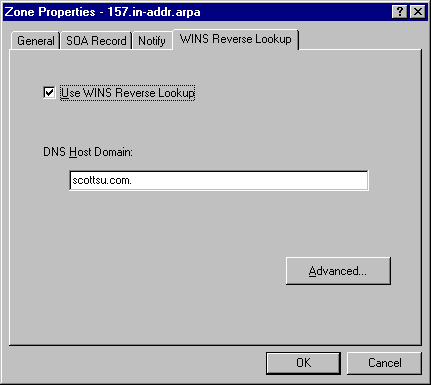
Ping -a 128.247.145.207
DNS: 0x1:Std Qry for 207.145.247.128.in-addr.arpa of type Dom. name ptr on class INET addr.
DNS: Query Identifier = 1 (0x1)
DNS: DNS Flags = Query, OpCode—Std Qry, RD Bits Set, RCode—No error
DNS: Question Entry Count = 1 (0x1)
DNS: Answer Entry Count = 0 (0x0)
DNS: Name Server Count = 0 (0x0)
DNS: Additional Records Count = 0 (0x0)
DNS: Question Section: 207.145.247.128.in-addr.arpa of type Dom. name ptr on class INET addr.
DNS: Question Name: 207.145.247.128.in-addr.arpa
DNS: Question Type = Domain name pointer
DNS: Question Class = Internet address class
Note that the Question name is the IP address backwards 207.145.247.128.in-addr.arpa of type PTR.
*****************************************************************************************************************************
DNS: 0x1:Std Qry Resp. for 207.145.247.128.in-addr.arpa of type Dom. name ptr on class INET addr.
DNS: Query Identifier = 1 (0x1)
DNS: DNS Flags = Response, OpCode—Std Qry, AA RD RA Bits Set, RCode—No error
DNS: Question Entry Count = 1 (0x1)
DNS: Answer Entry Count = 1 (0x1)
DNS: Name Server Count = 0 (0x0)
DNS: Additional Records Count = 0 (0x0)
DNS: Question Section: 207.145.247.128.in-addr.arpa of type Dom. name ptr on class INET addr.
DNS: Question Name: 207.145.247.128.in-addr.arpa
DNS: Question Type = Domain name pointer
DNS: Question Class = Internet address class
DNS: Answer section: 207.145.247.128.in-addr.arpa of type Dom. name ptr on class INET addr.
DNS: Resource Name: 207.145.247.128.in-addr.arpa
DNS: Resource Type = Domain name pointer
DNS: Resource Class = Internet address class
DNS: Time To Live = 86400 (0x15180)
DNS: Resource Data Length = 23 (0x17)
DNS: Pointer: scottsu-7.scottsu.com
namedroppers is the discussion forum of the DNS working group of the Internet Engineering Task Force, and is also used by the dnsind working group. The mission of dnsind is to work on extending the protocols relating to DNS to incorporate incremental zone transfers, change notification, and dynamic updates. Subscription requests should be sent to majordomo@internic.net. General DNS questions are not appropriate for this forum. Up-to-date archives are available.
dns-security is the discussion forum of the dnssec working group of the IETF. Subscription requests should be sent to dns-security-request@tis.com.
All-in-one tutorial style DNS reference for those using BIND. Excellent for beginning to intermediate DNS administrators; lacks coverage of advanced topics.
ISBN: 1-56592-010-4
Contains a self-contained overview of DNS as just one of the standard network services in a TCP/IP environment.
An update to Nemeth and Snyder’s classic, now features Chapter 16 dedicated to DNS. Especially good for the feature comparison of currently shipping vendor variants.
Good all-round security book with a practical approach. Chapter 8 includes a detailed section on DNS in a firewall environment.
Microsoft Windows NT 3.5/3.51: TCP/IP Implementation Details (
Part No. 098-62170)DHCPWINS.DOC (Part No. 098-56544)
The Domain Name System (DNS) & Internet Naming and Directory Services—by Dr. Paul Mockapetris
Miscellaneous
DNSAdmin.HLP
Appendix C:
Getting Registered with the NIC
Domain-request@uunet.uu.net (703) 876-5050
CIC@sh.cs.net (617) 873-2777
domains%bitnic.bitnet@cunyvm.cuny.edu
Send e-mail to listserv%bitnic.bitnet@cunyvm.cuny.edu
with text "SEND DOMAIN GUIDE"
This file contains examples and a template along with explanations.
Domain registration form
FTP://rs.internic.net/templates/domain-template.txt
**********************************************************************
Il
documento originale Microsoft da cui ho fatto questo adattamento in htm puo'
essere scaricato cliccando qui
chiramente tutti marchi ed i nomi presenti in questa pagina non sono miei,
ma dei rispettivi proprietari.
ciao
Mario